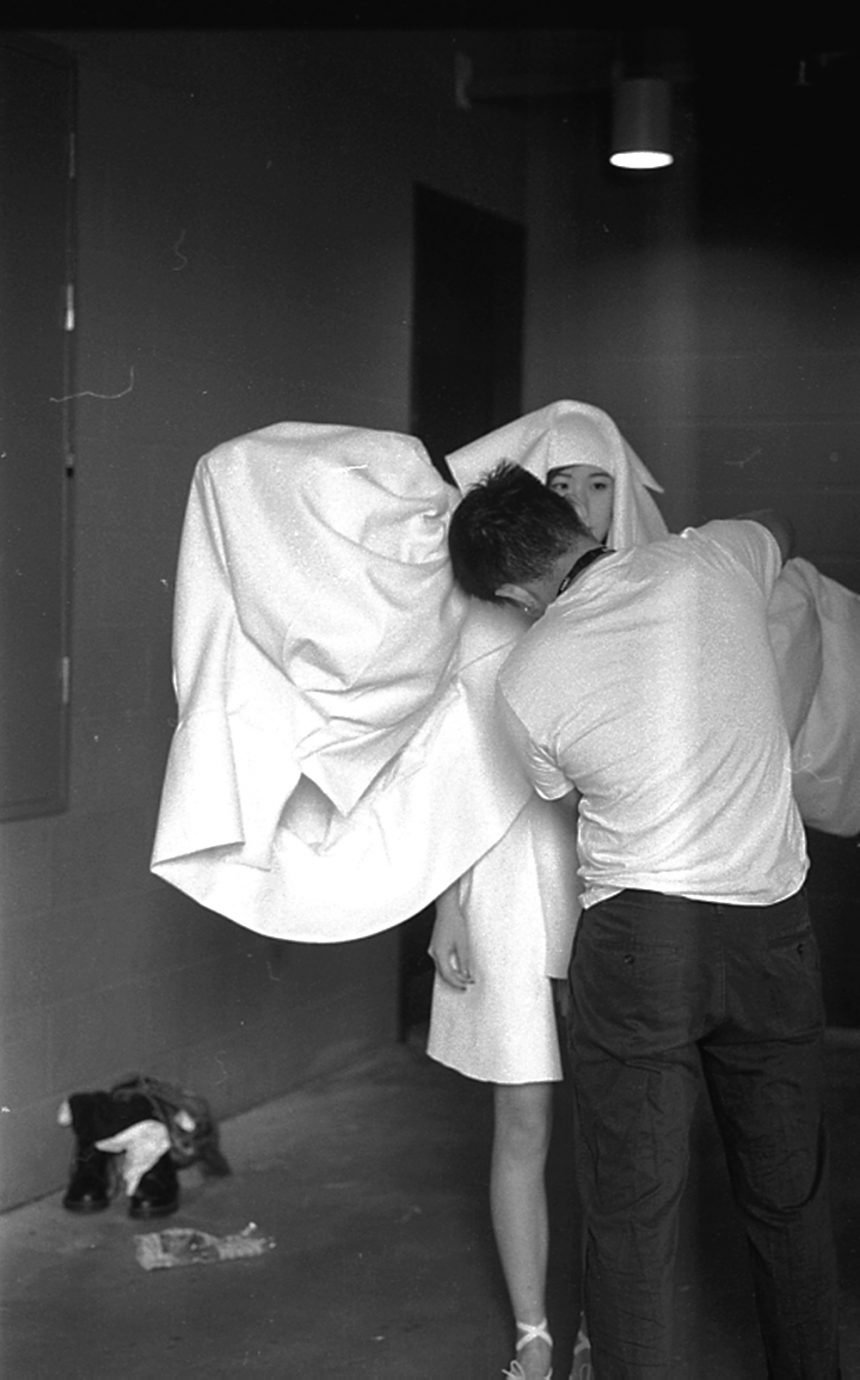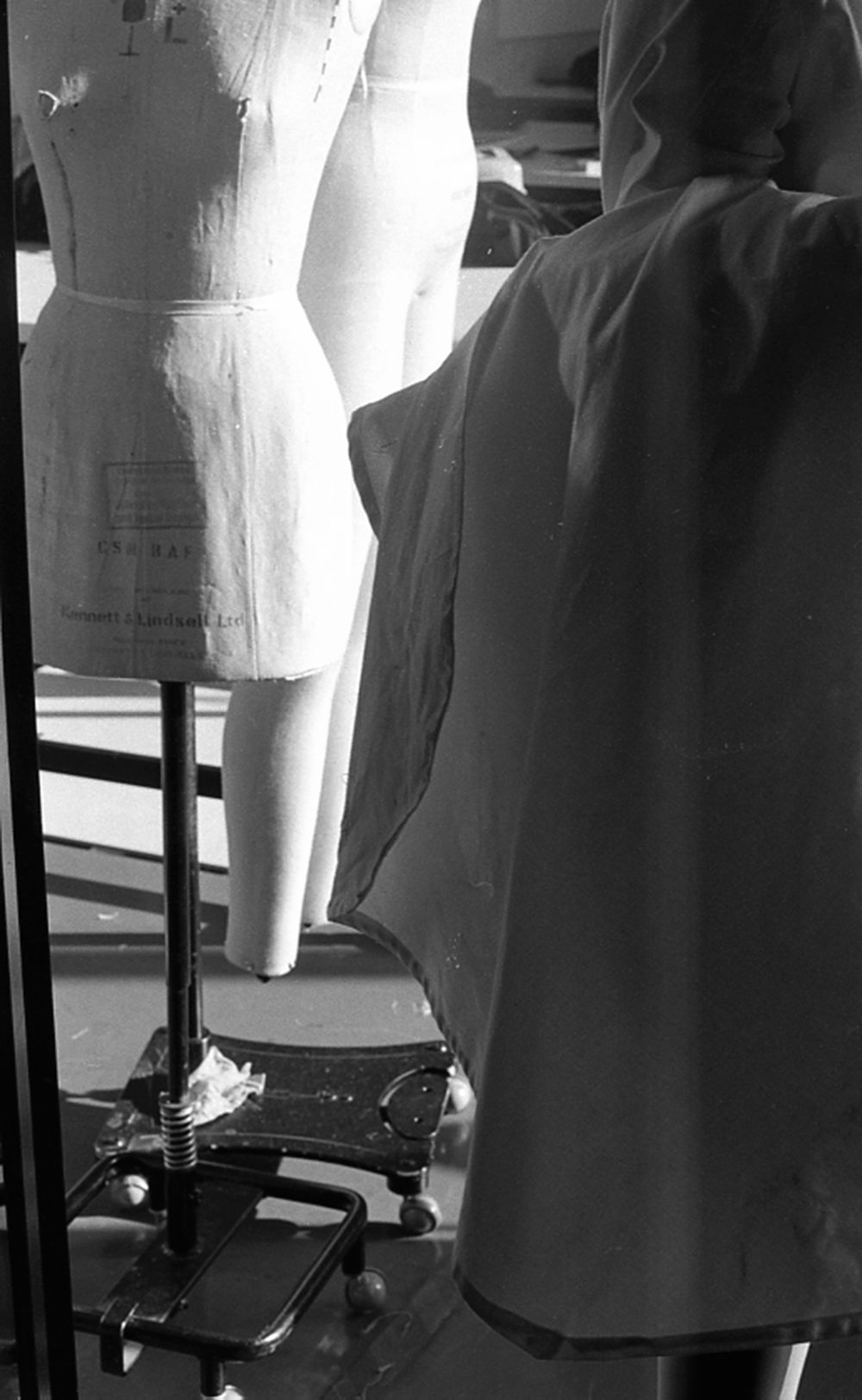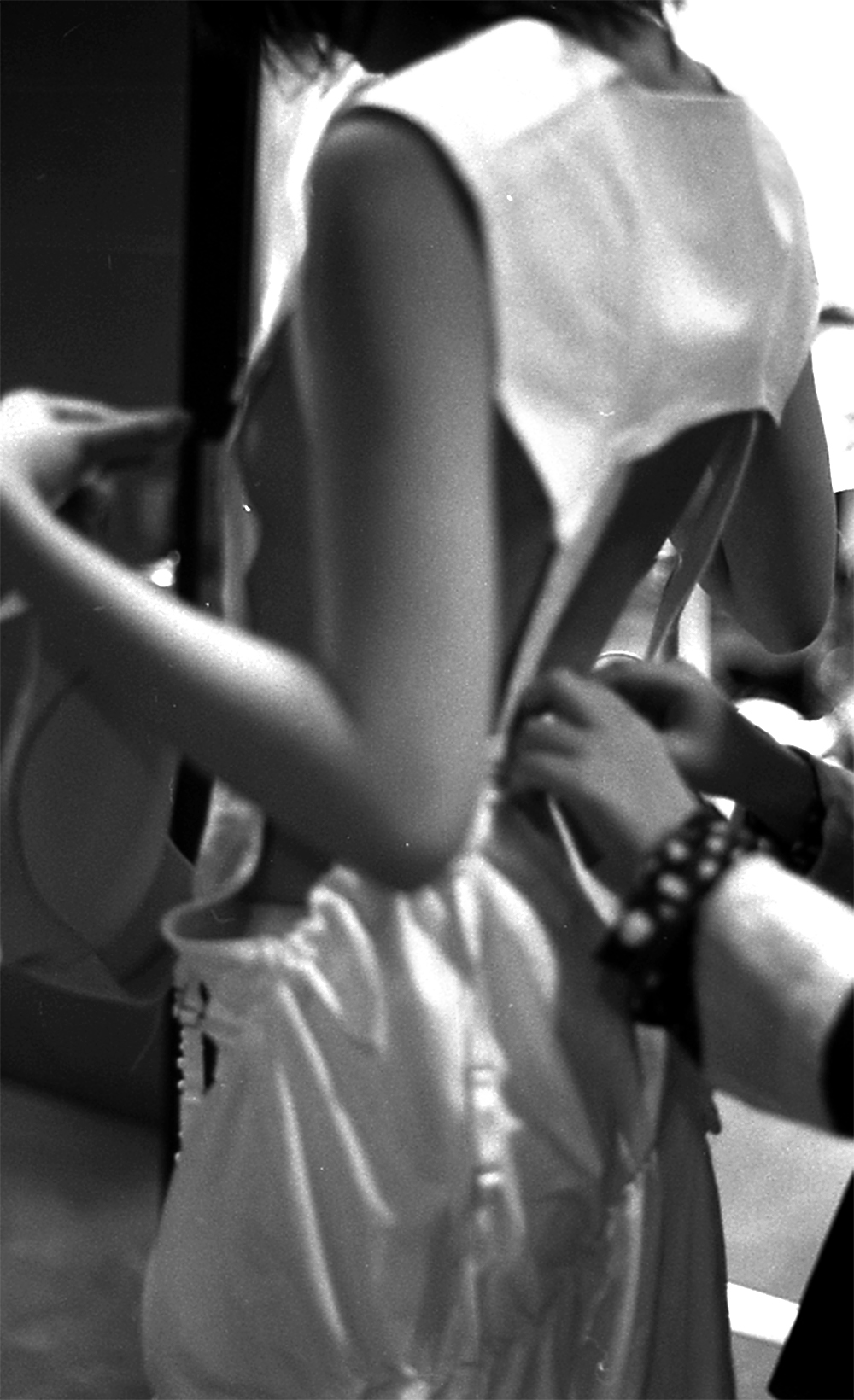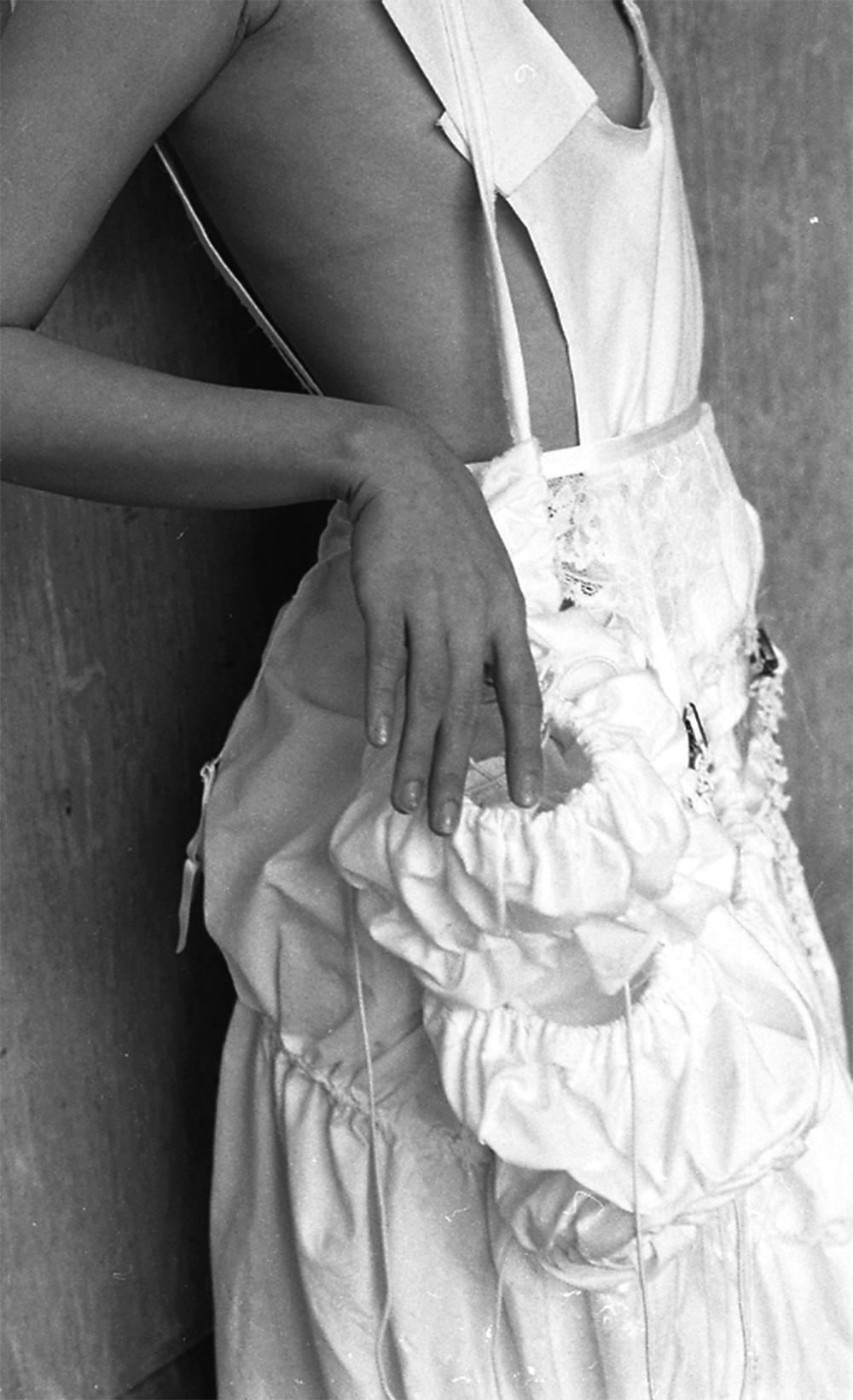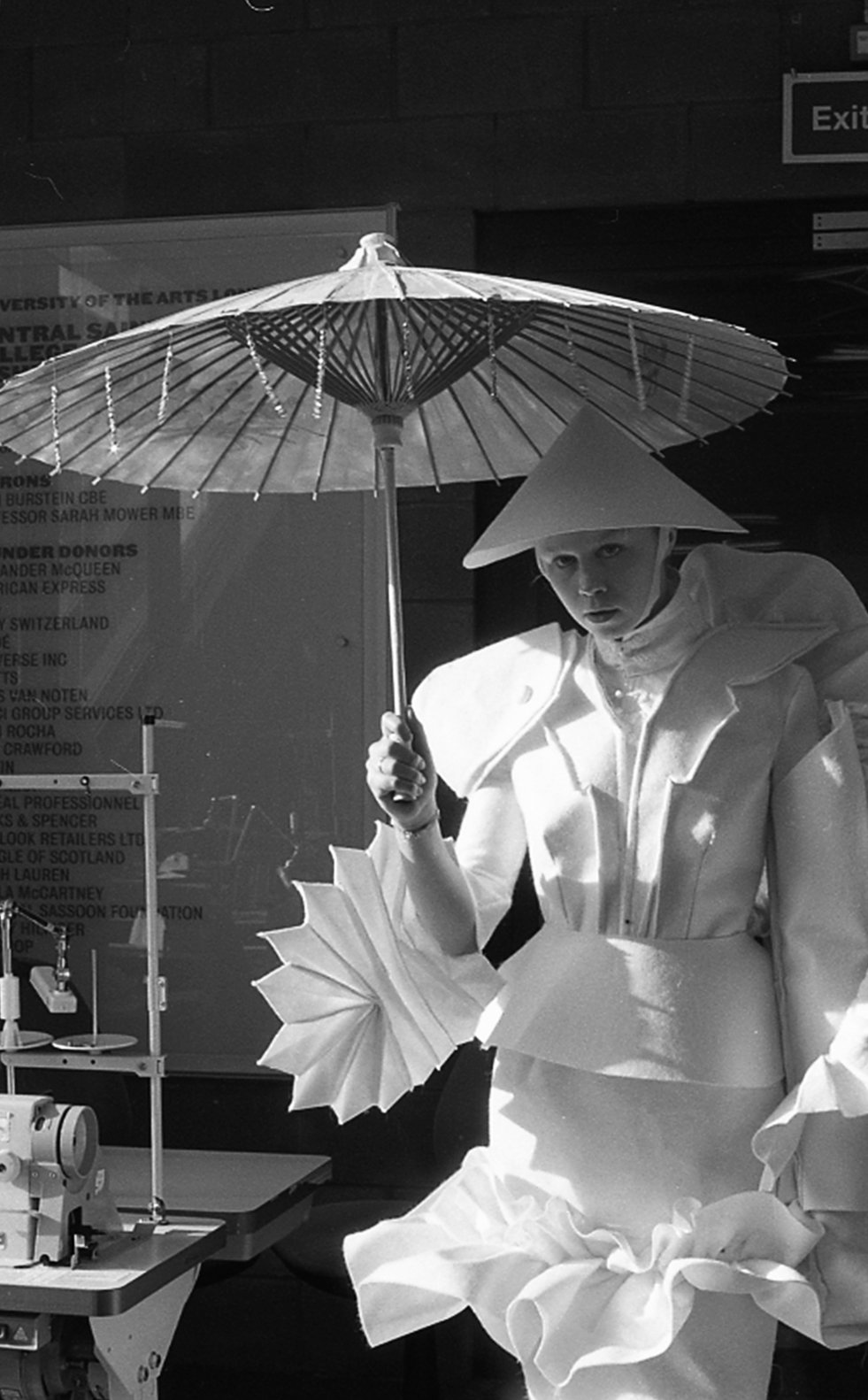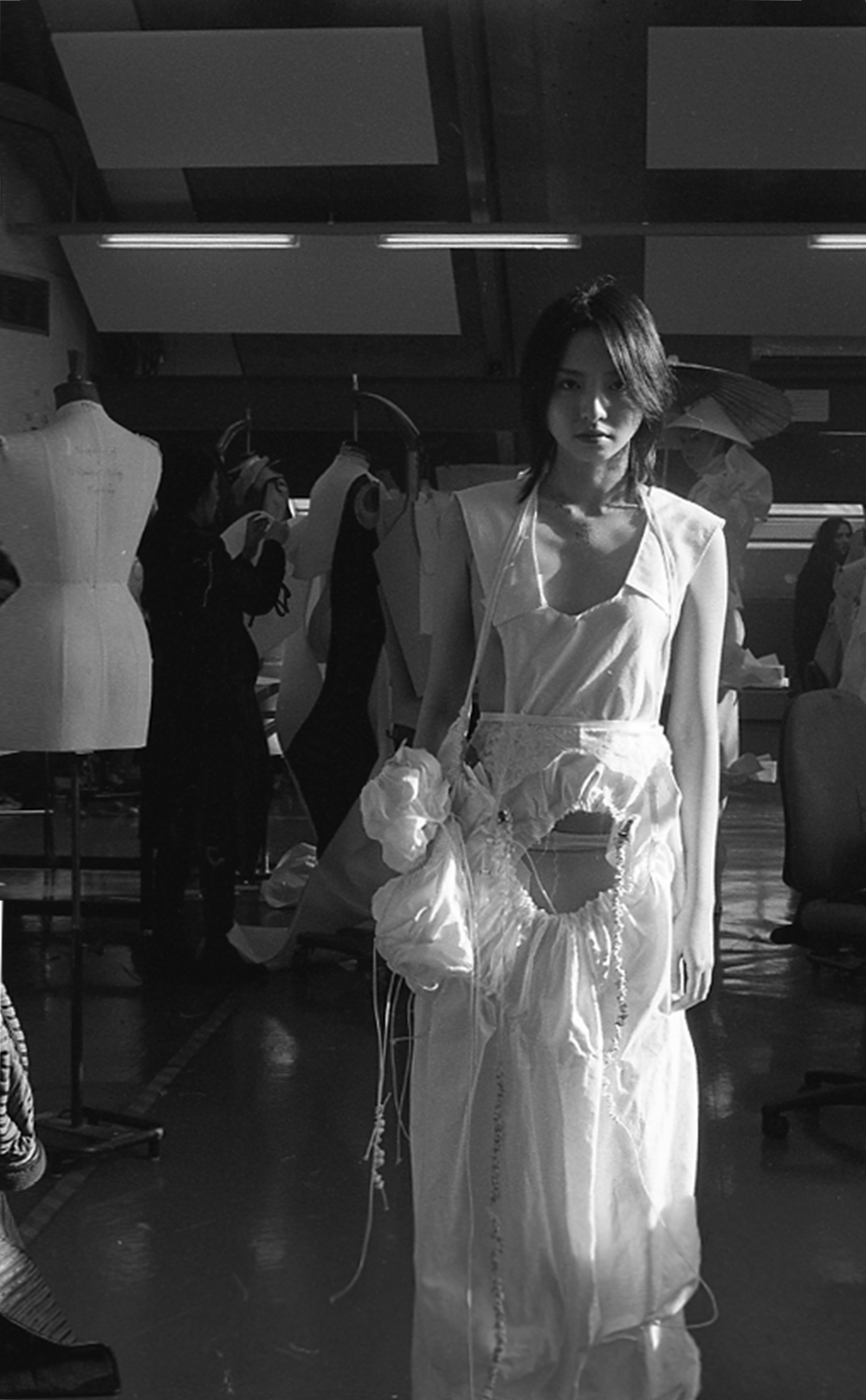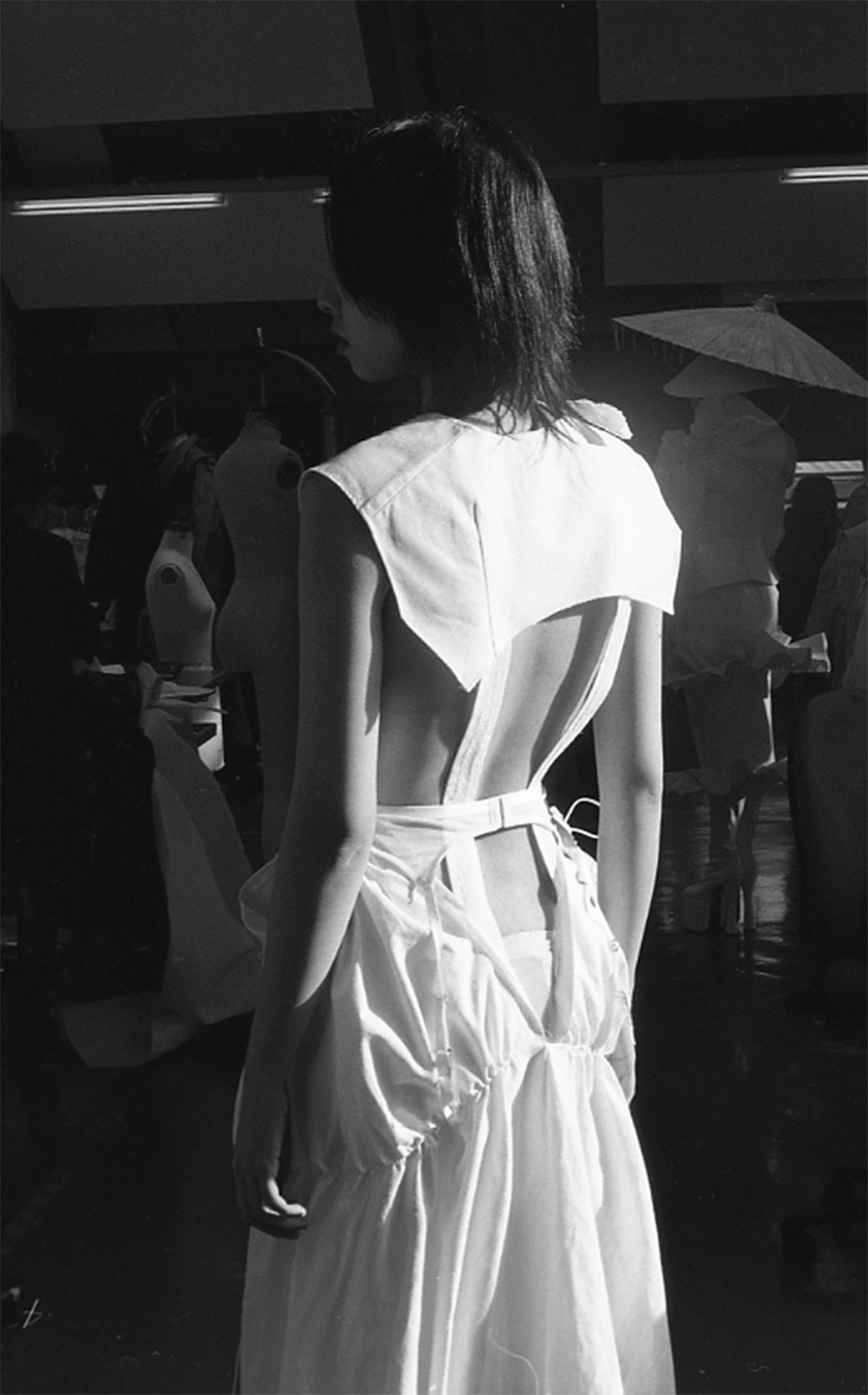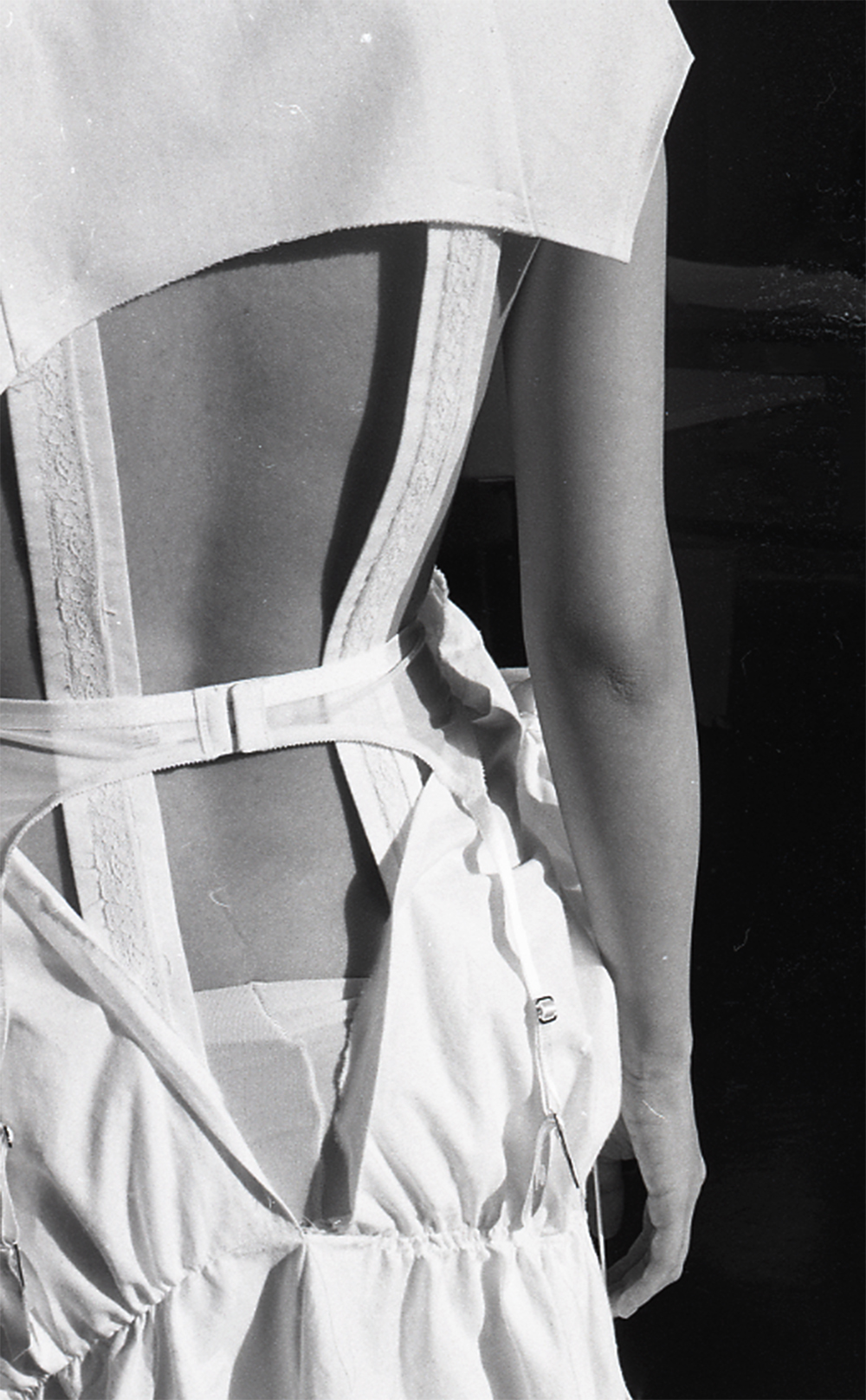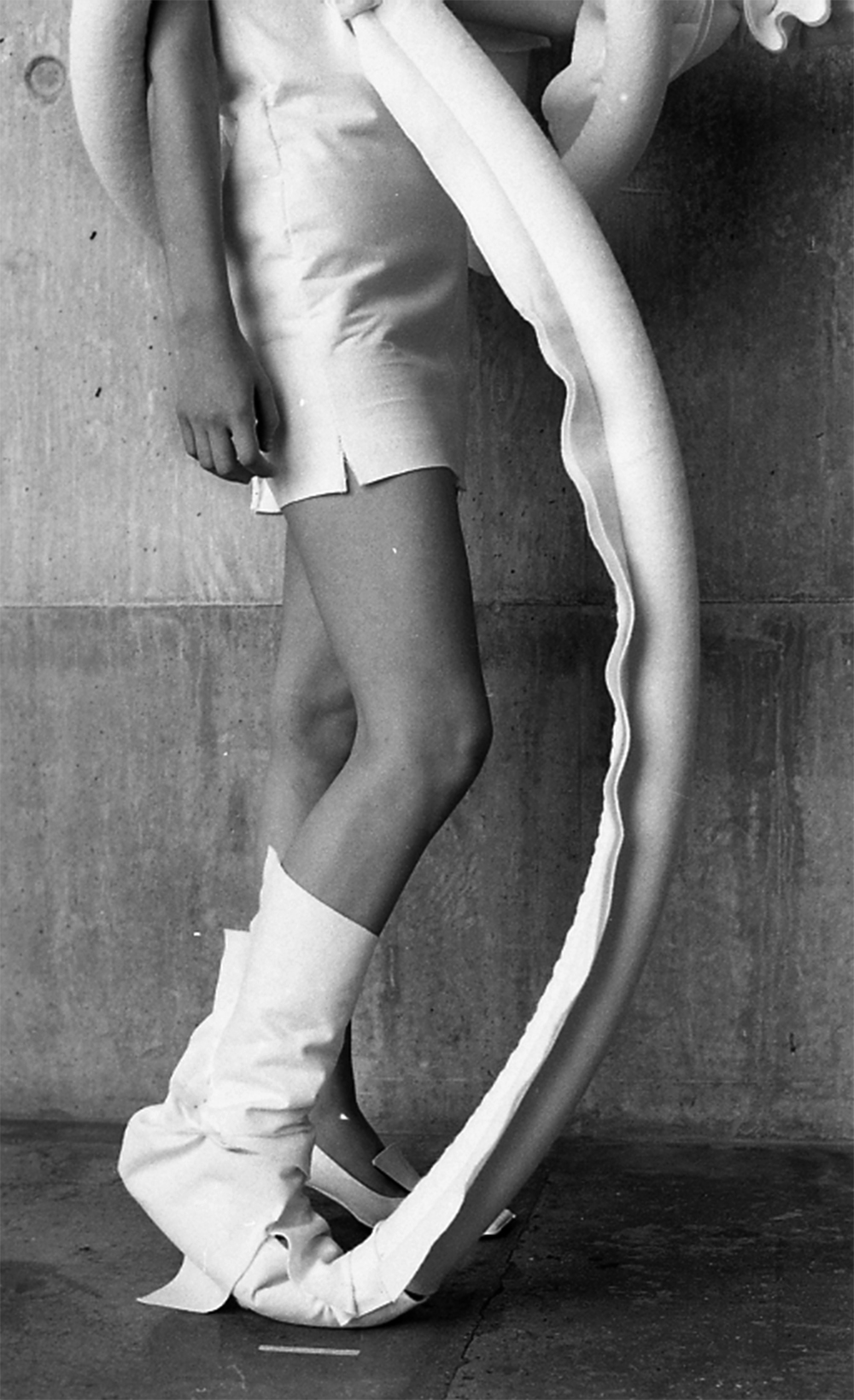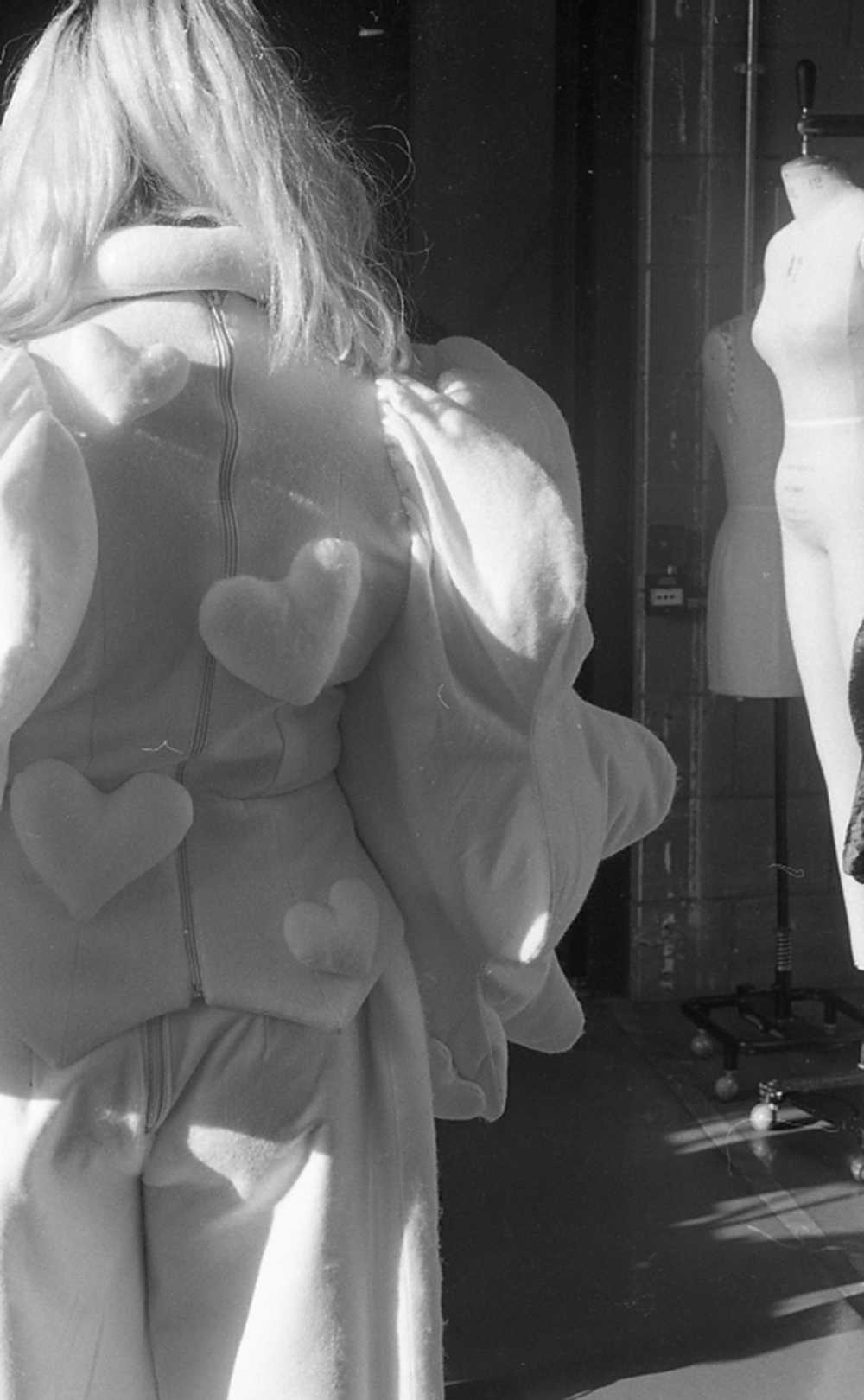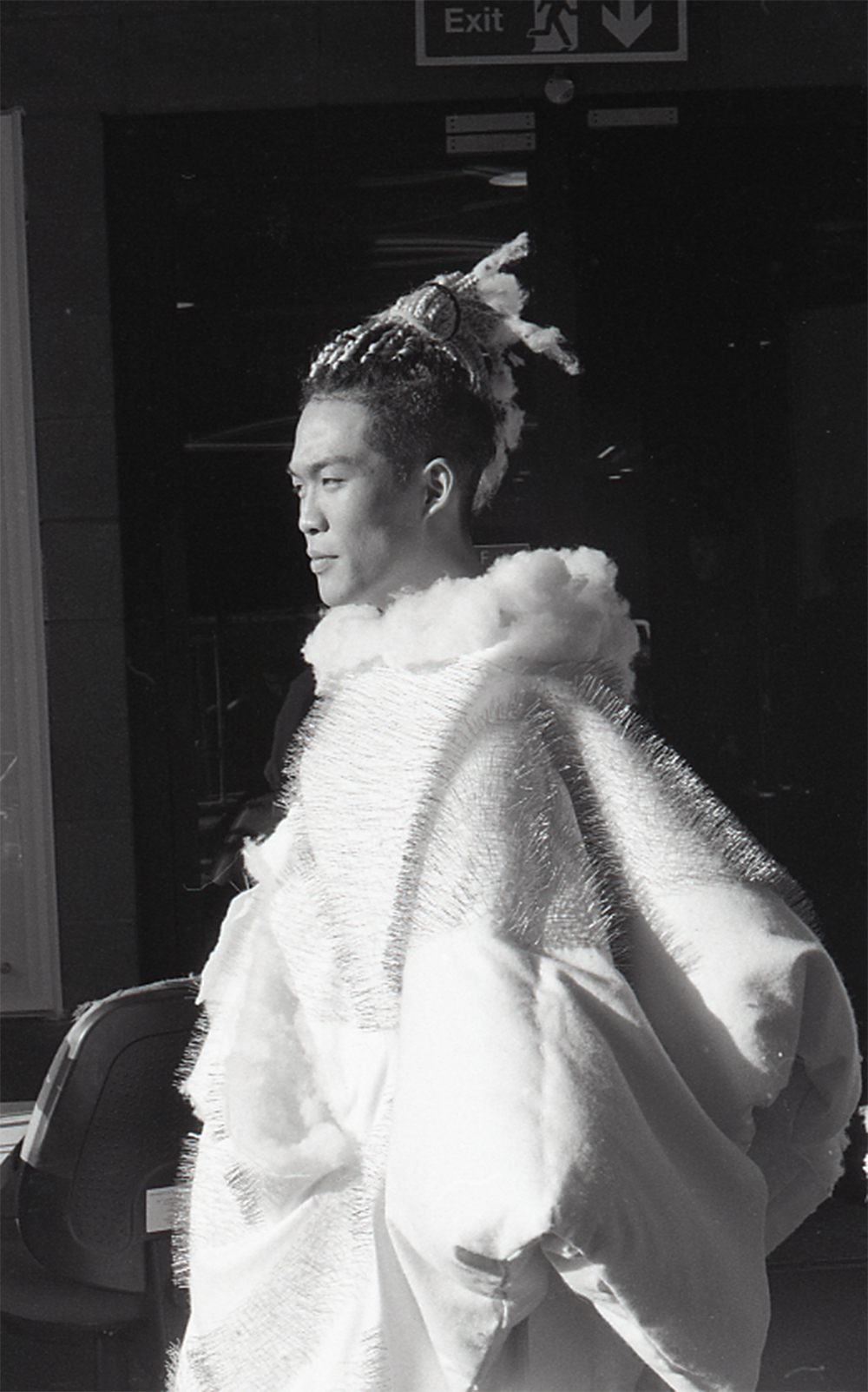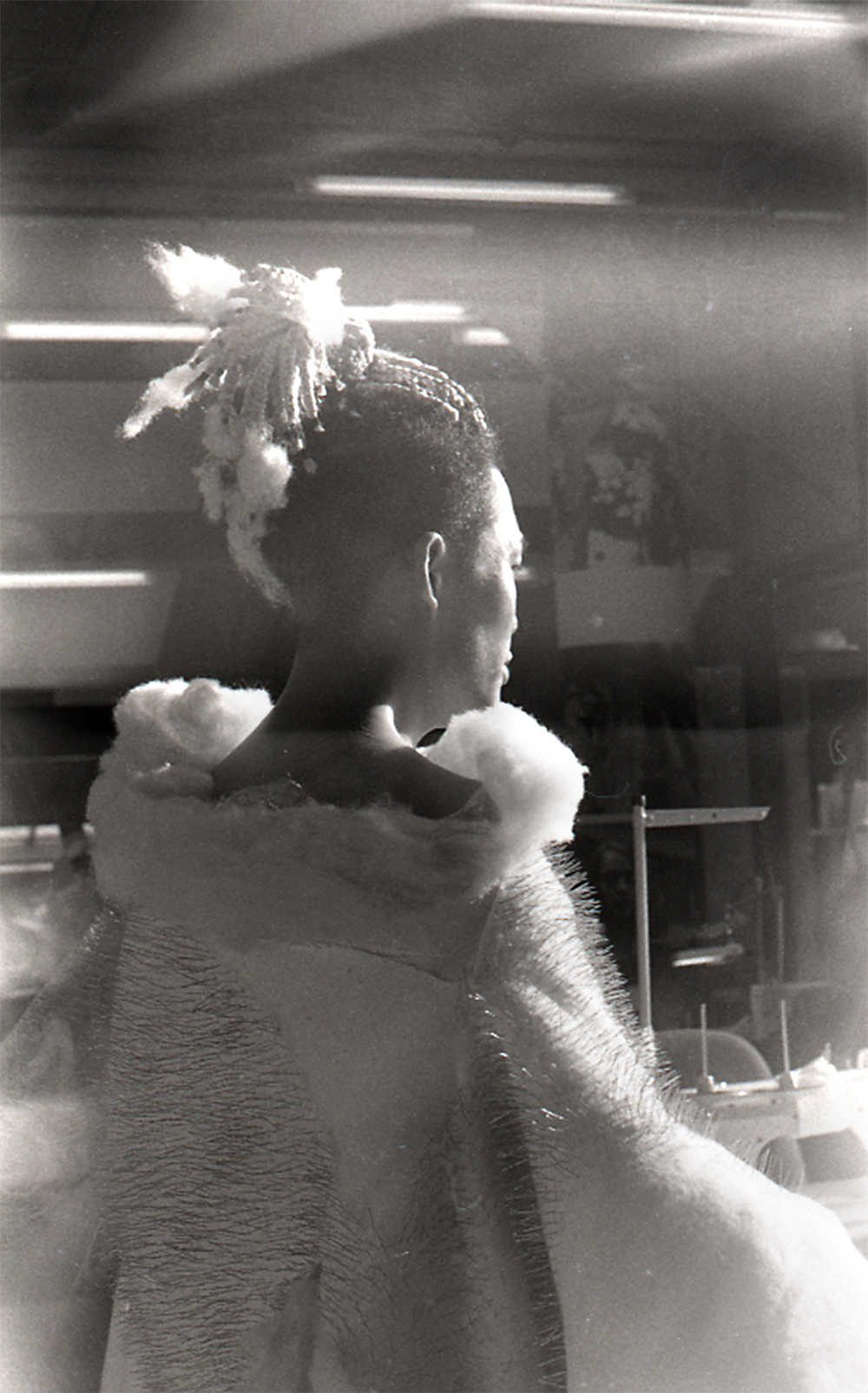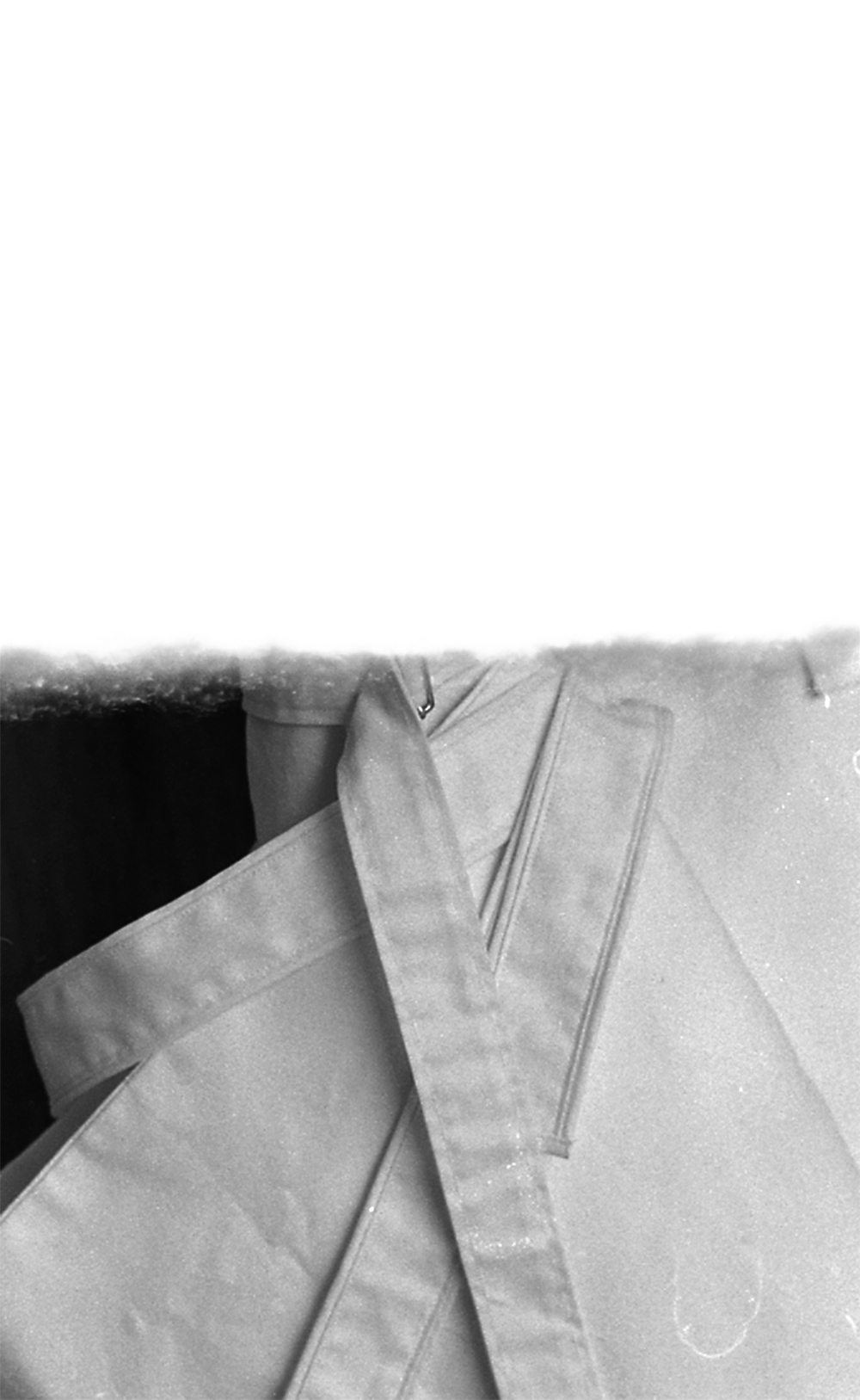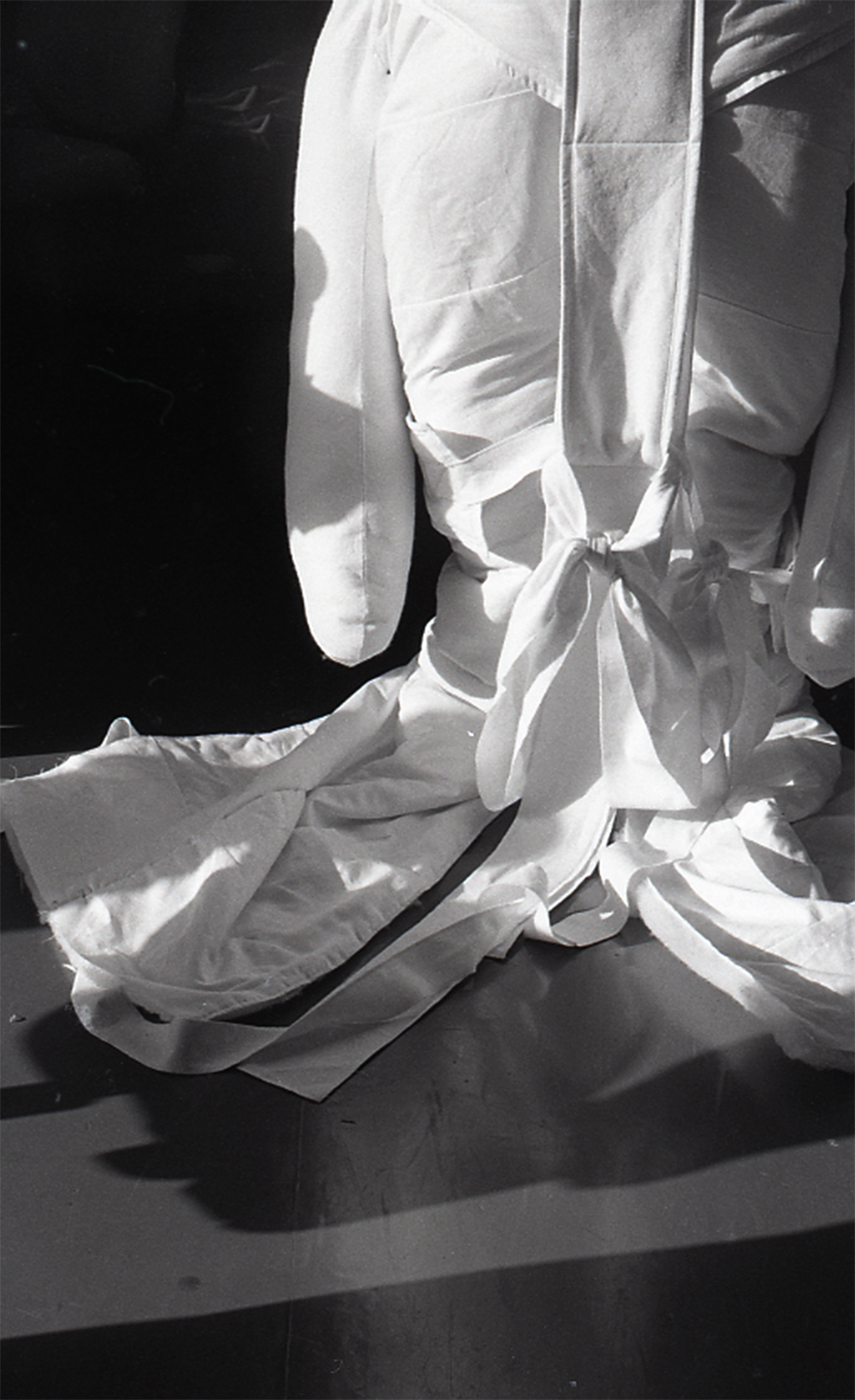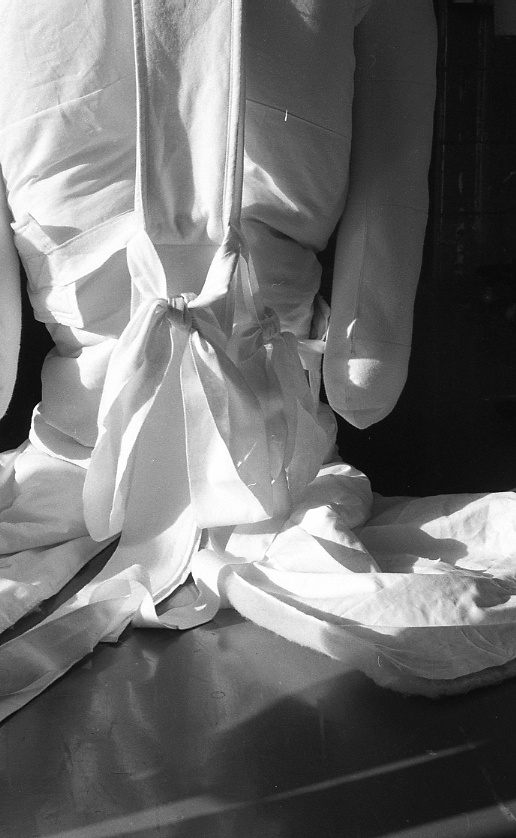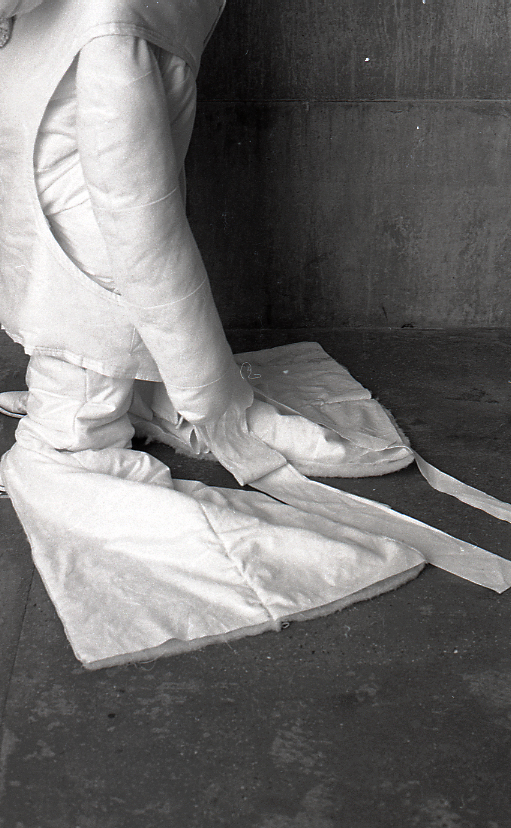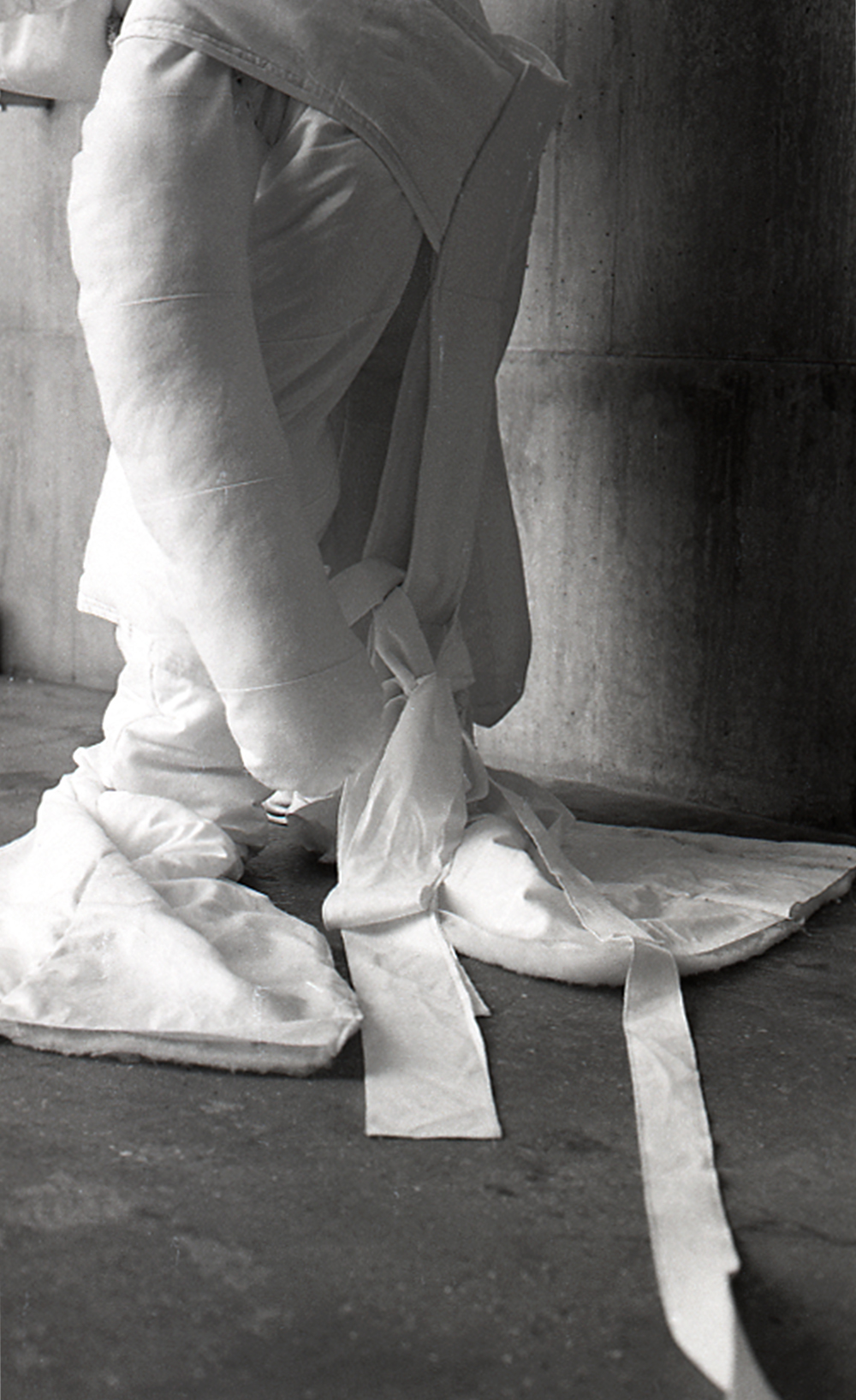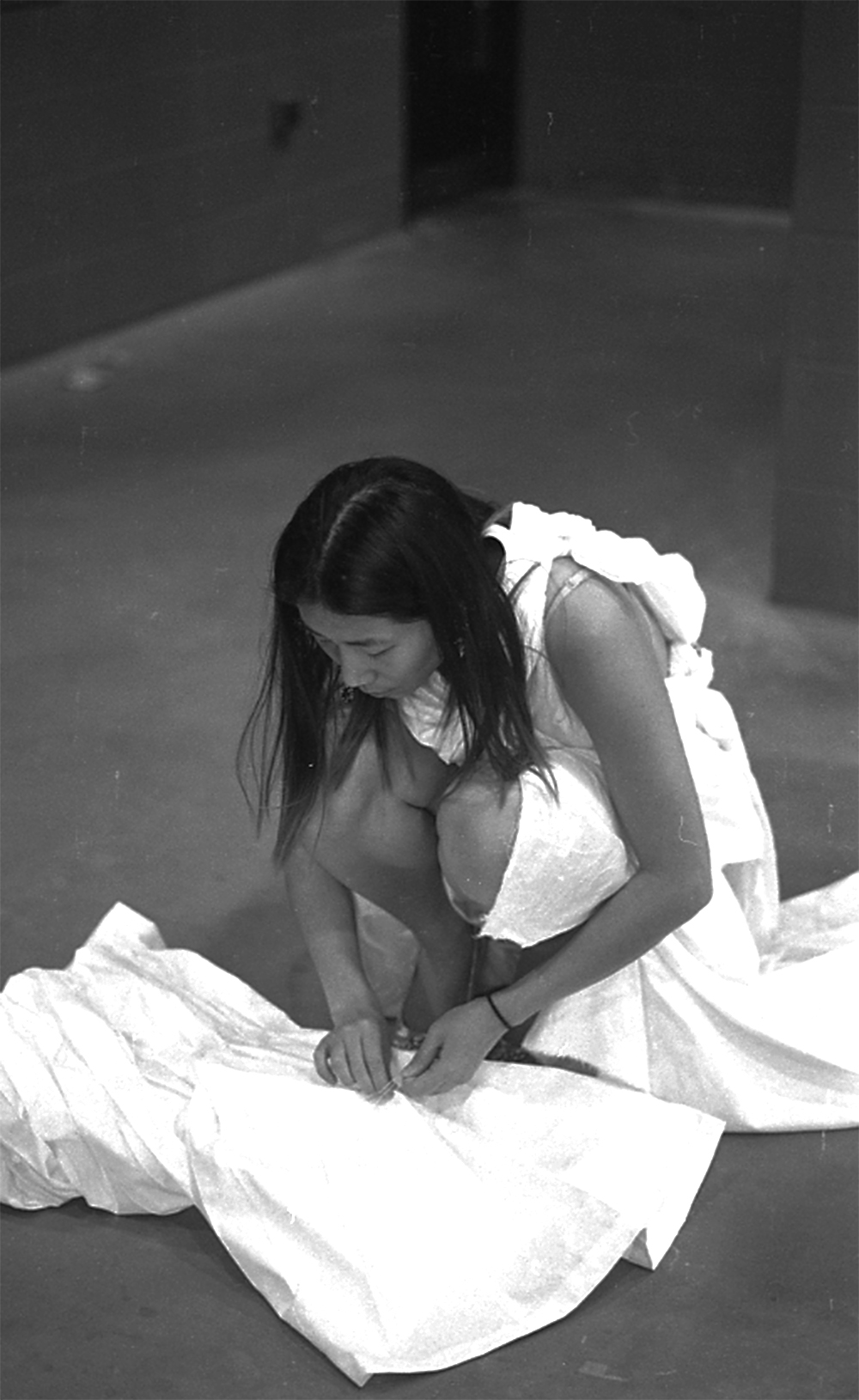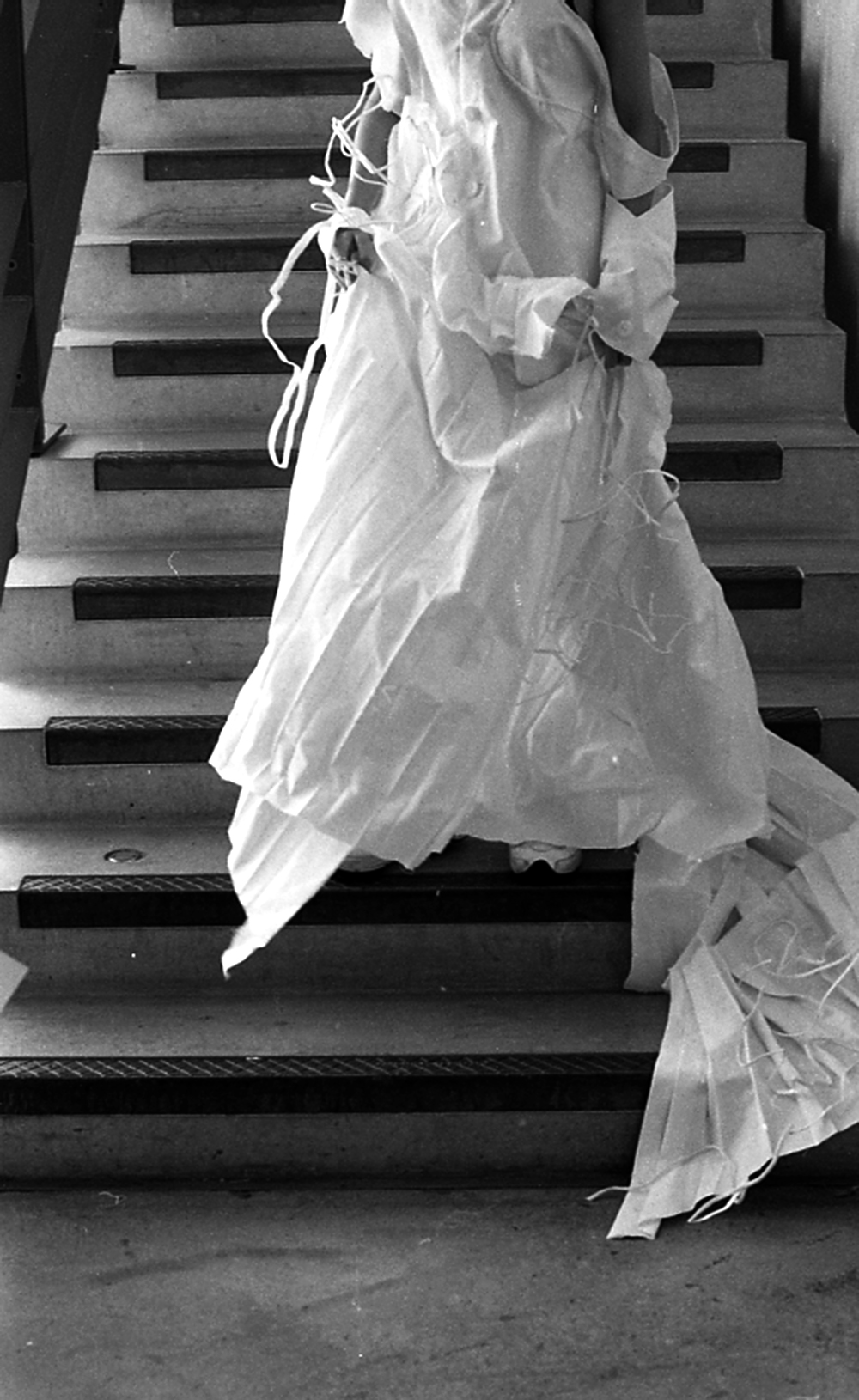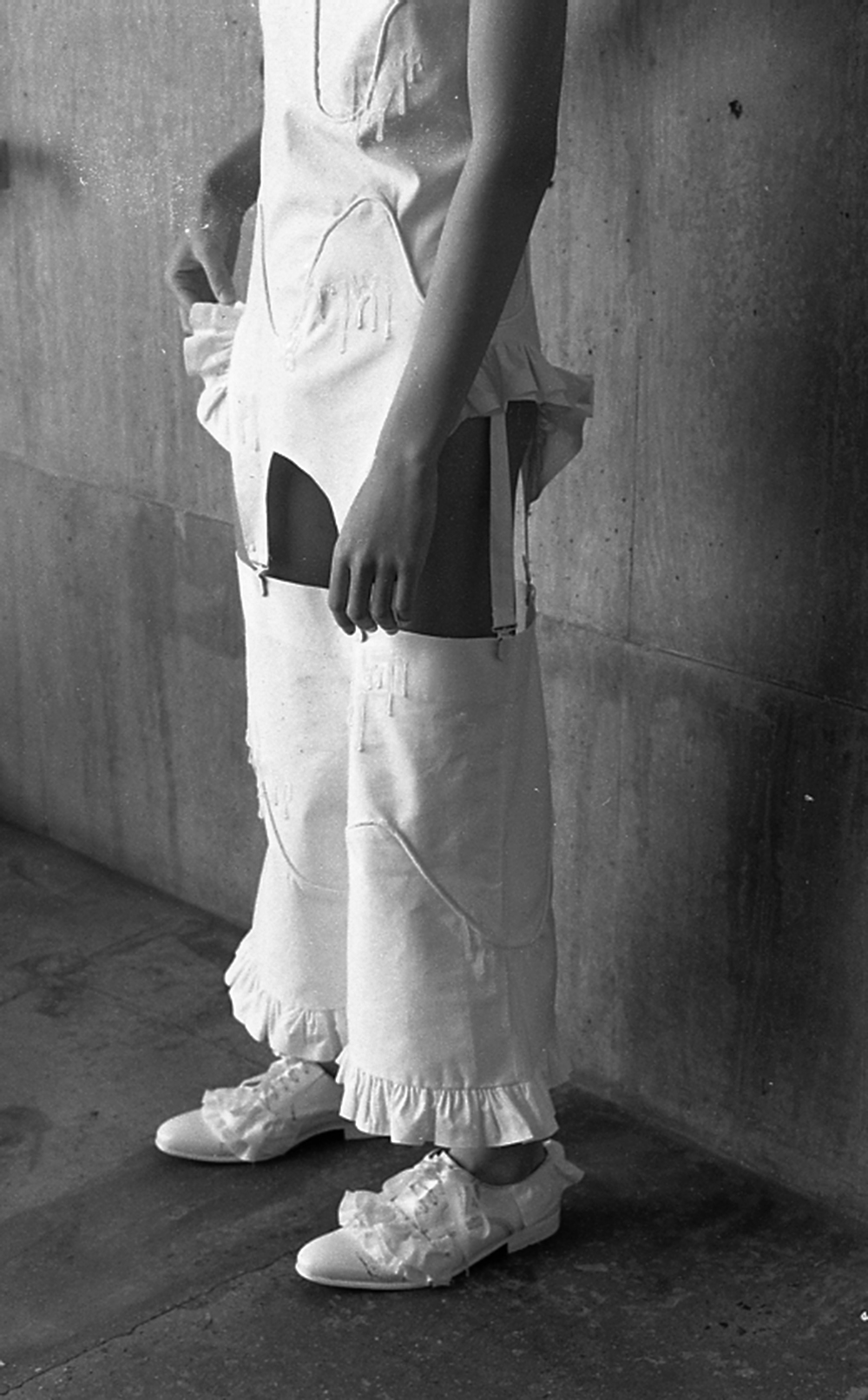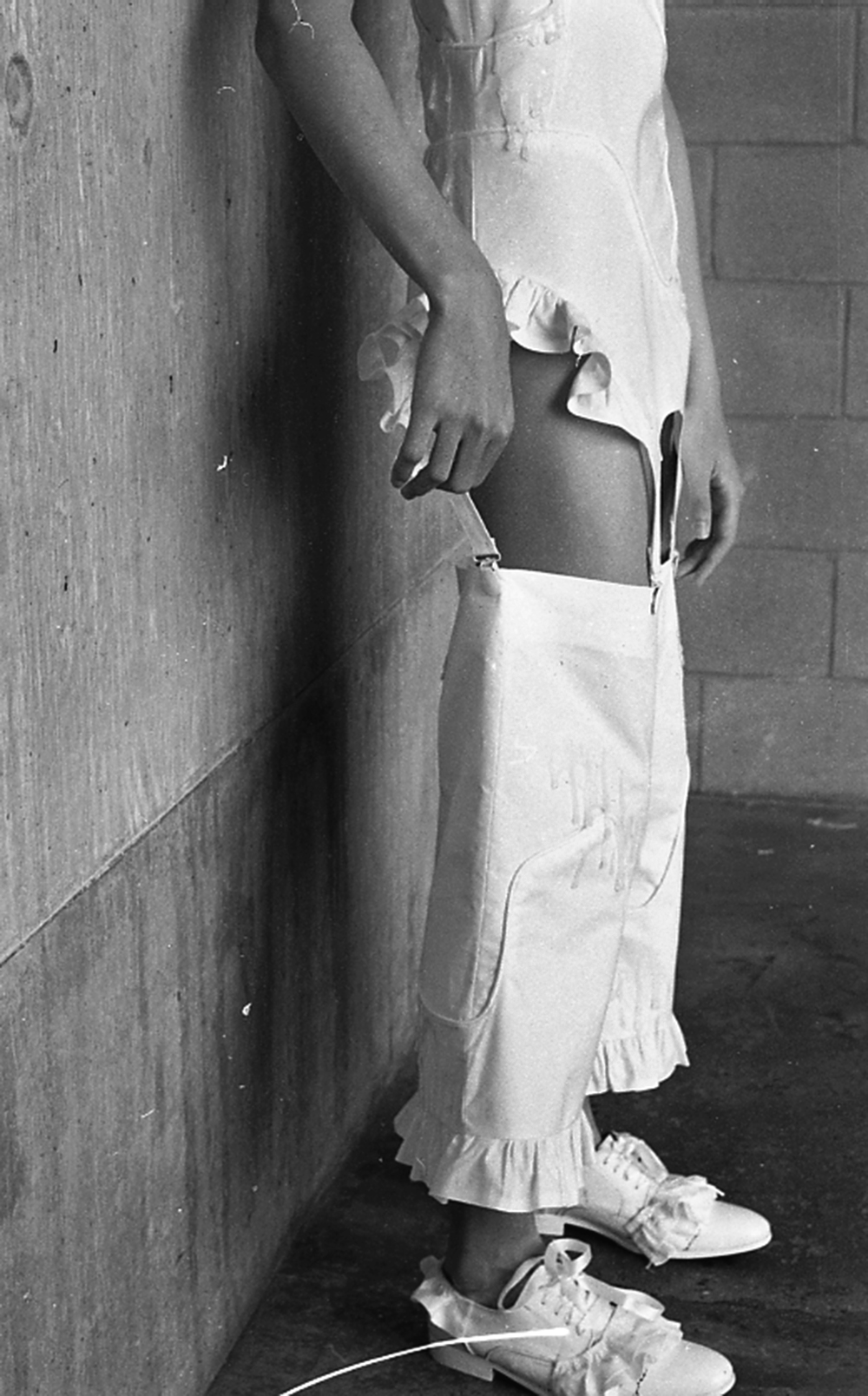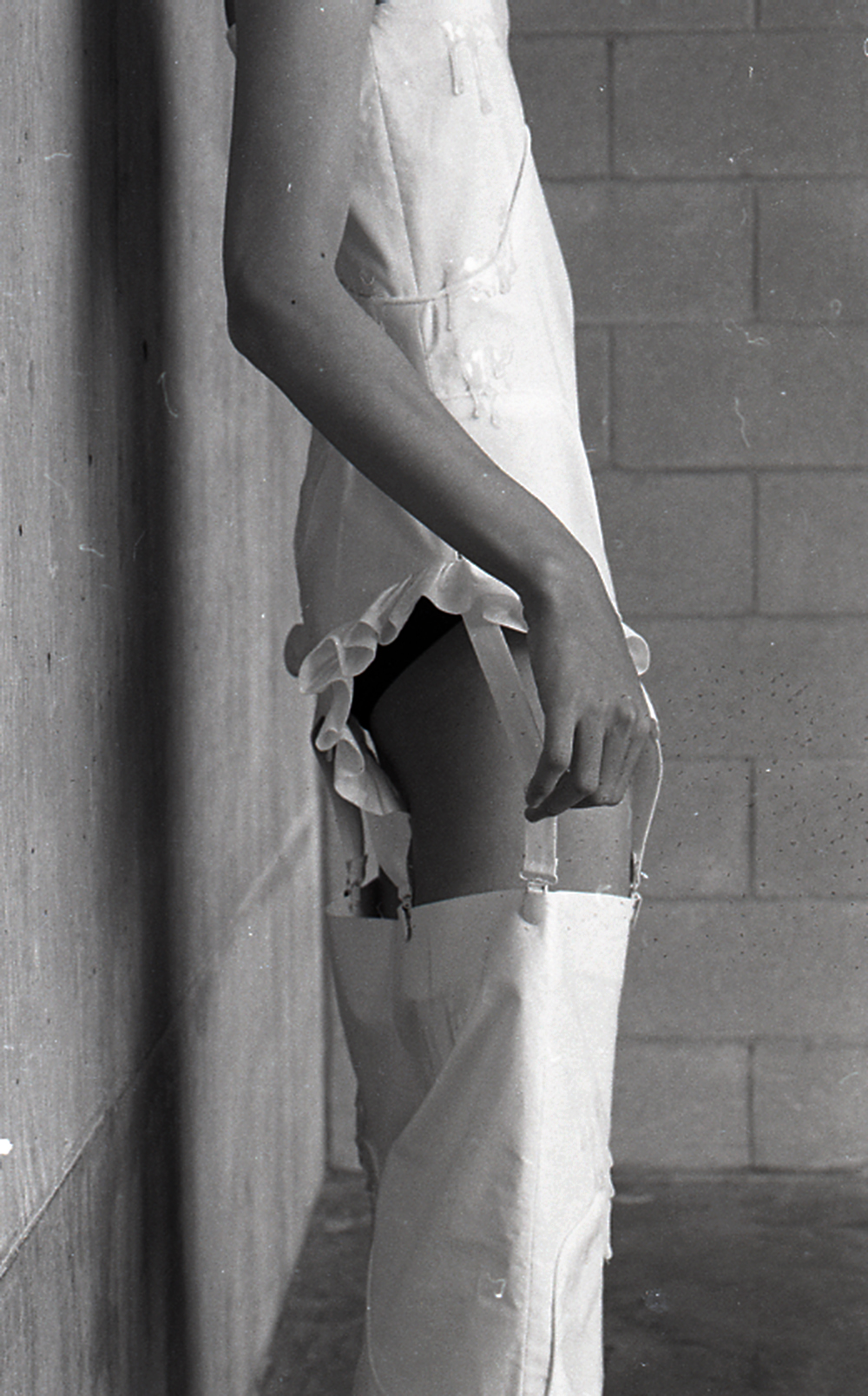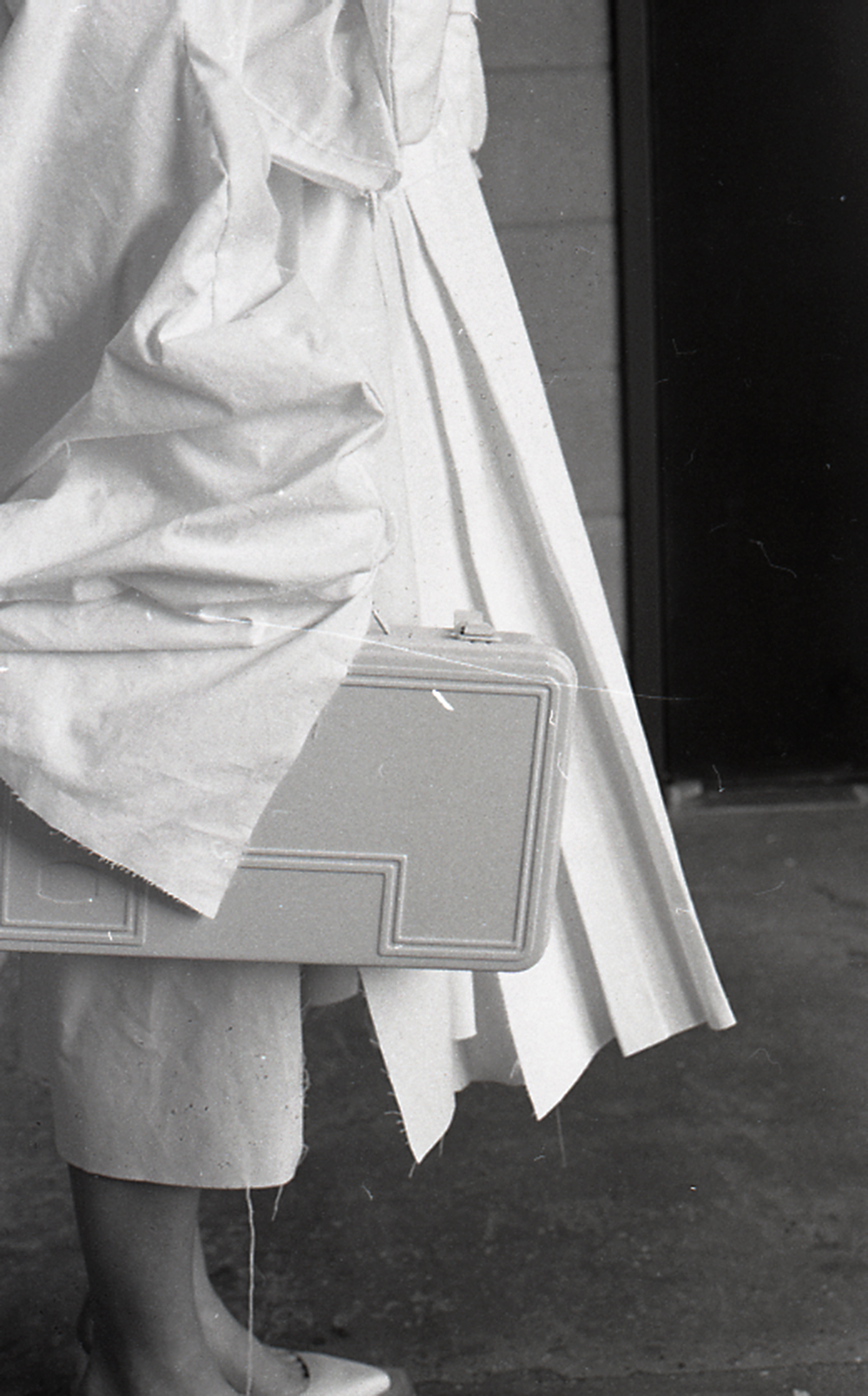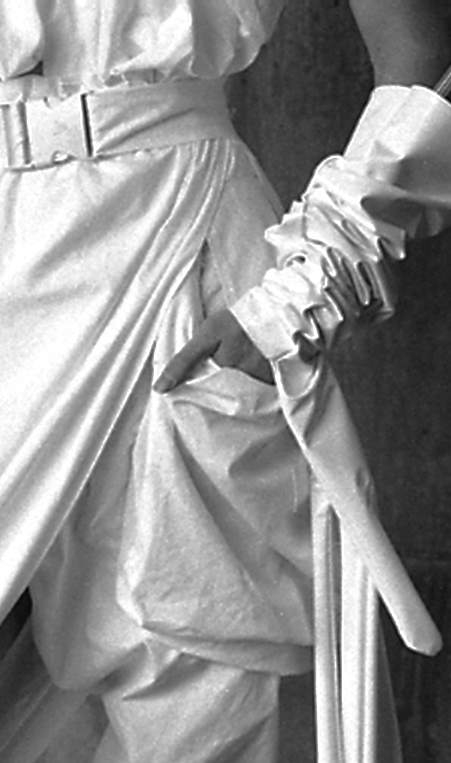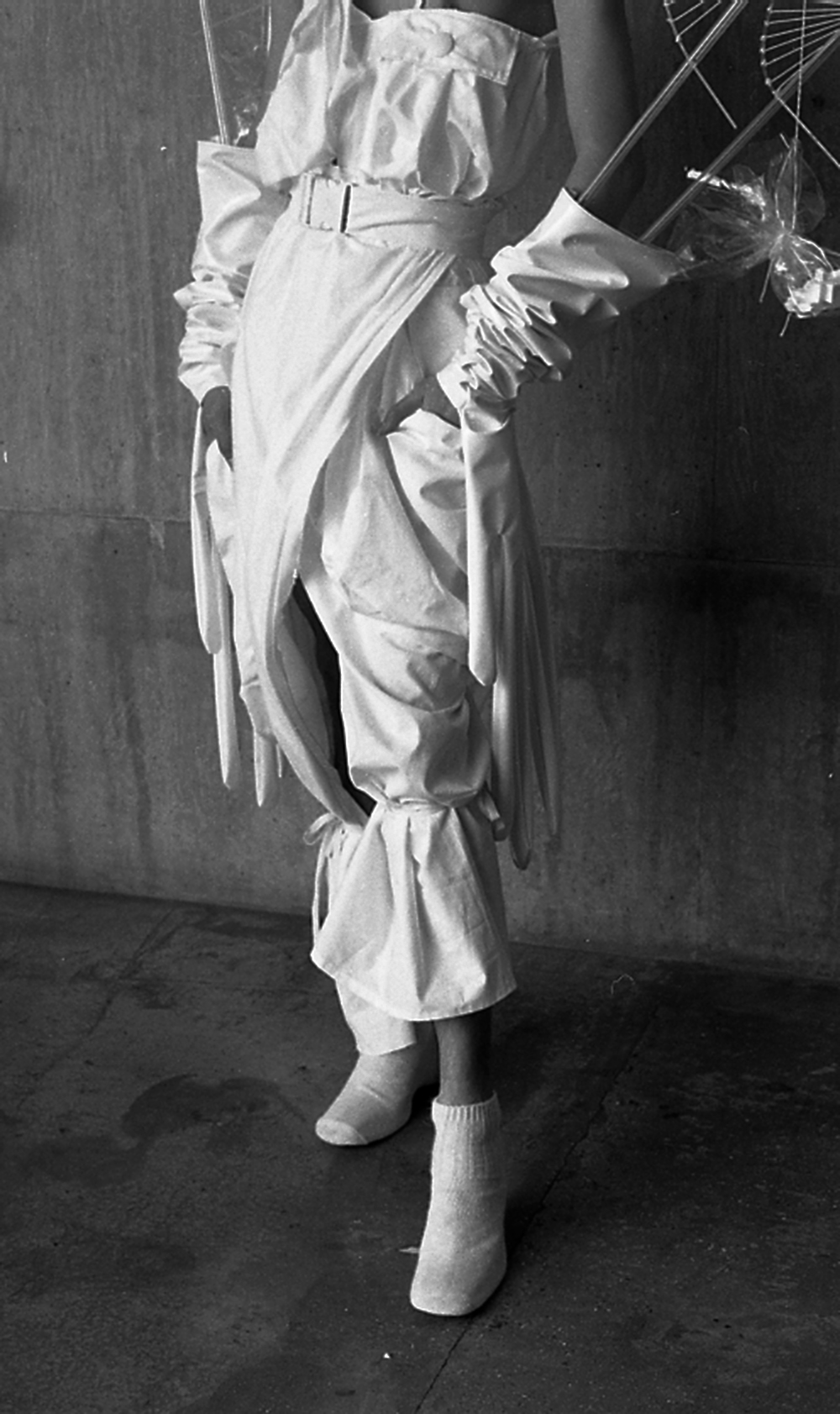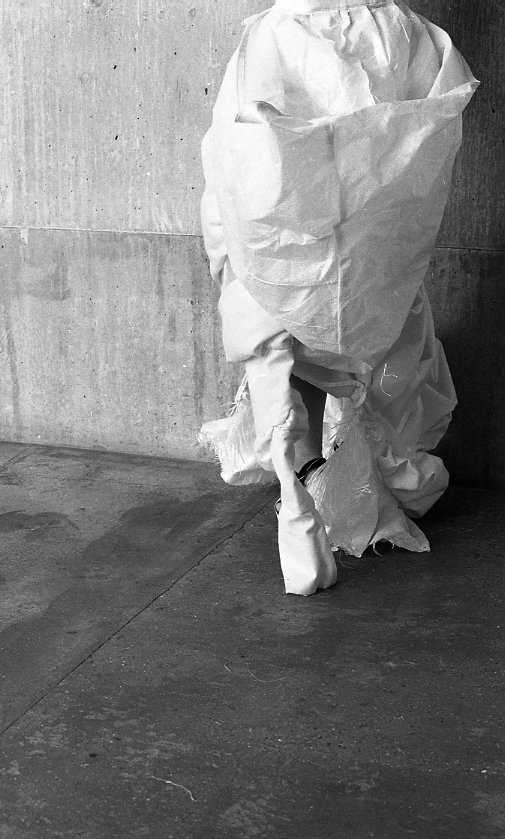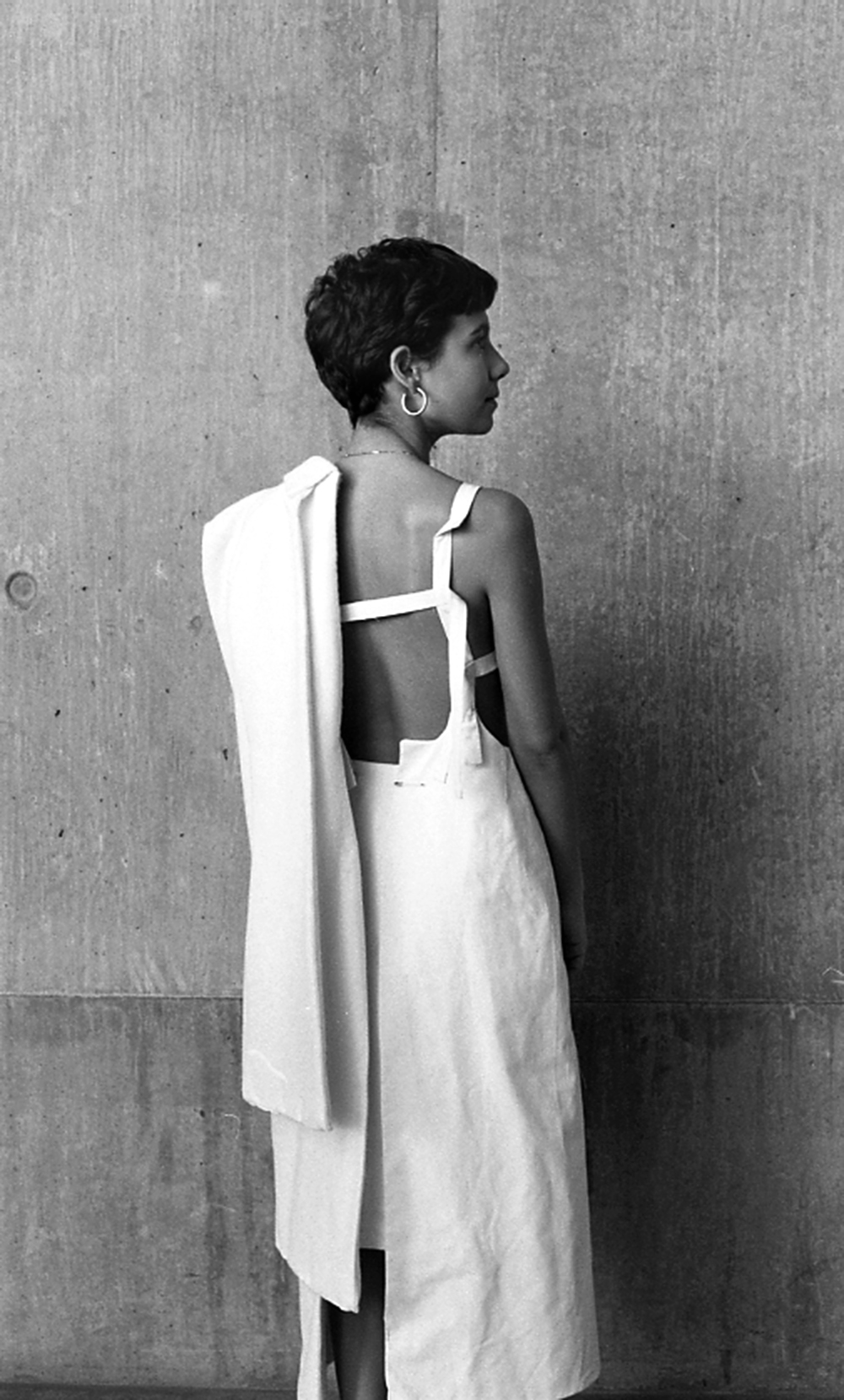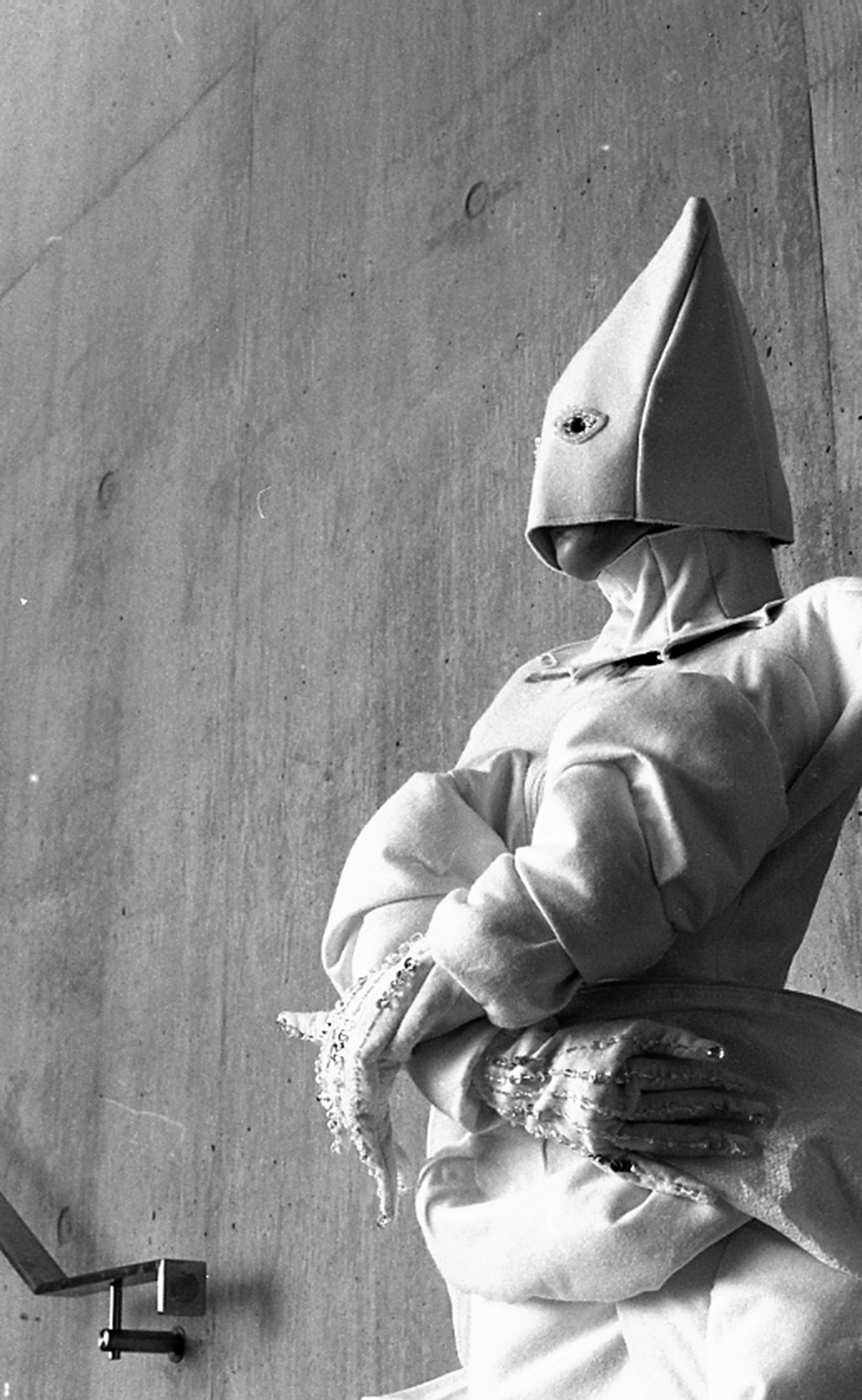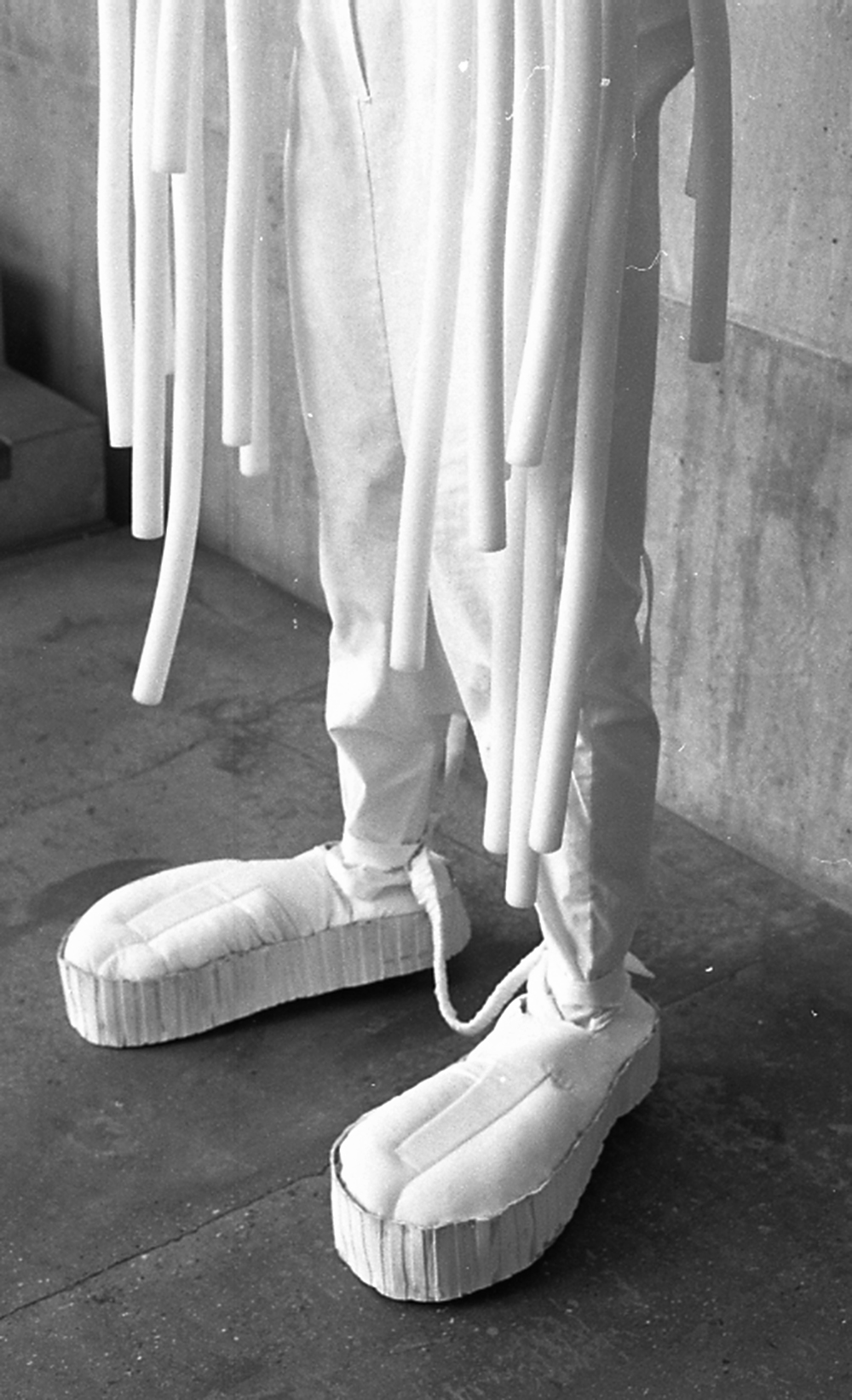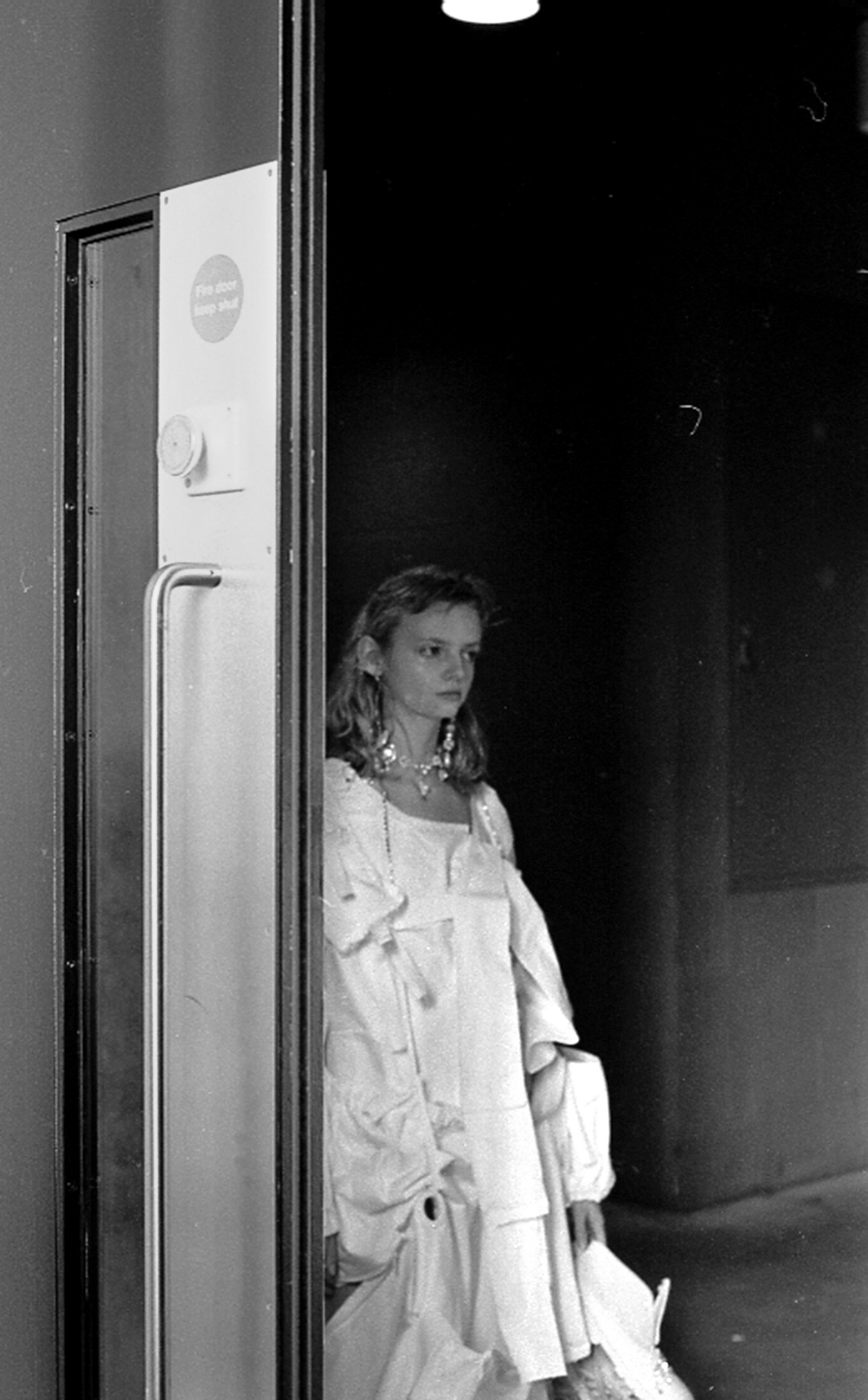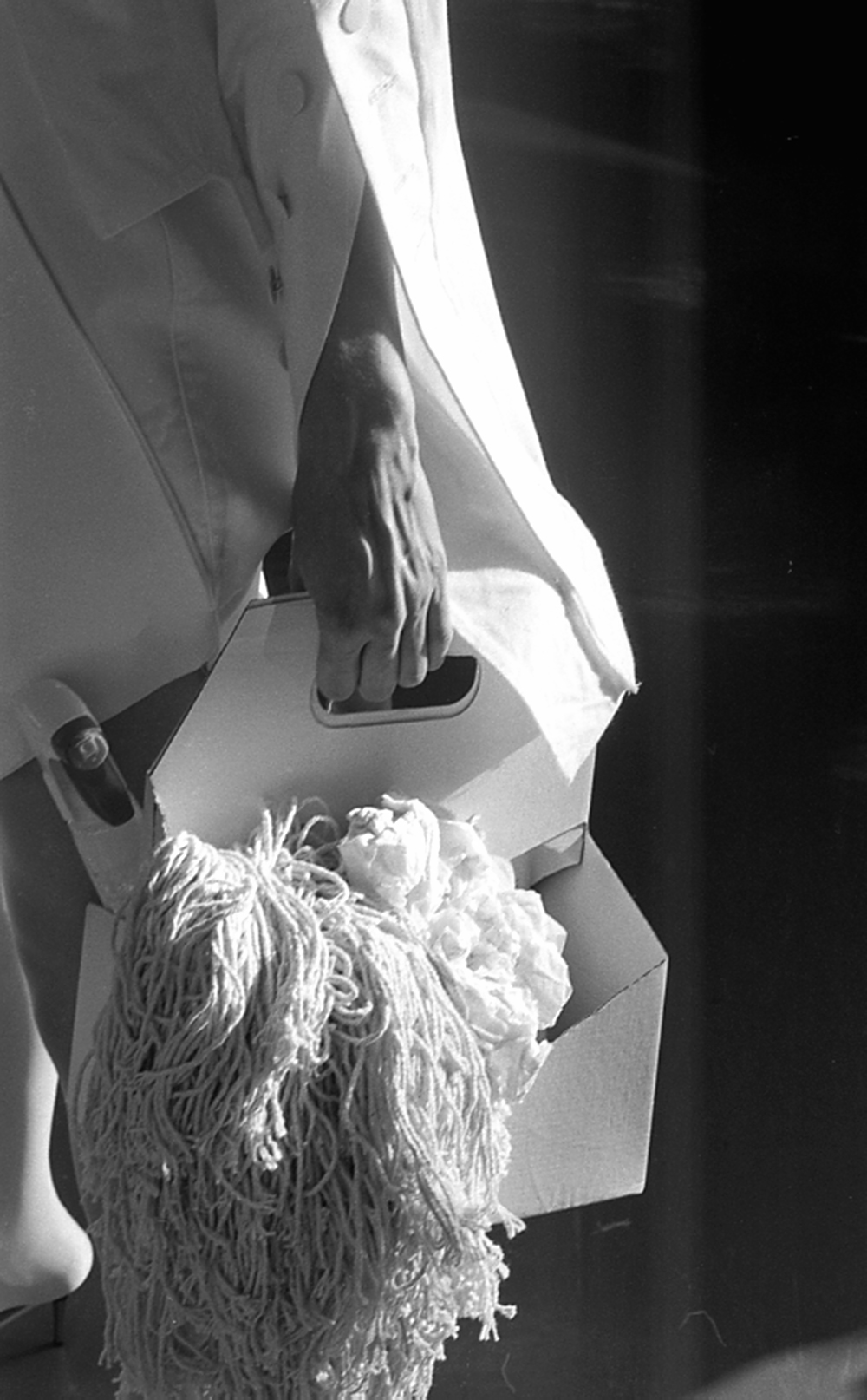Can you remember any of the looks of those who are now ‘the great’ in the industry?
L: Henrik Vibskov, who did the blow-up [construction] with the fan – it was inflatable. There was something very structured about his piece, which is what he does now – more sculptural pieces.
E: I don’t bloody remember anything. There was someone who did a cocoon in Print at Charing Cross Road – the cocoon has obviously been quite popular.
L: No, it’s all a blur for us.
“What we want to happen is not for them to become us, but to become better than us.”
As you’ve done this project for such an extensive time – could you say what is so important about the white show?
L: It’s a really great project for first years, actually. They all start from the same field, the same canvas, all-white. I think what’s quite nice about the White Show, for me, is that they all start, join us and present their work with a show [the White Show] and then they end with us with a show [the BA Degree Show]. It’s the opening and the closing of their lifespan at CSM. They all start with the same fabric, it’s all equal.
E: The other thing that’s interesting is how even people without skill take risks and do things – even if they are not really beautifully made. It’s an experience and it’s a way of learning. I think quite a lot of them find the shirt project more difficult, actually, than the white project.
L: They do get stressed, but I think that is because it’s their first time and they learn so much in a short period of time, and because they’ve got to show their work to their peers and other members of staff.
E: I think it’s really exciting for them, it’s exciting for anyone to do a show.
L: It’s exciting for me, my kneecaps keep jumping up and down.
E: In your first project, it’s exciting, isn’t it? But then I guess it makes a big expectation for the rest of your time here
L: What happens in second year, is that they try to forget the White Show. When they look back, they just want to make changes. They learn more skills, and as young creators, they are always going to want to make changes.
E: Some students couldn’t sew and couldn’t make [particular things], but then they find a way of doing it. Everyone is really motivated, I can say that about all the students.
L: It gives a grasp of what we are all about. The students are all quite independent. They learn a lot within that short period. For me and Esme – who both teach all year groups – what always reminds you is what they were like as first years. They had no skills and all of a sudden they just blossom and become independent. Some of them actually get better than me, which is annoying. Sometimes I’m sat there listening to some of their conversations and I hear myself. It’s interesting and I think that’s what we want to happen. Not for them to become us, but to become better than us.
E: And of course, lots of them are way more talented than us.
We know that every student is different, but is the “all white” perceived as a barrier, a challenge, or does it make things easier?
L: I think it’s easier overall. It’s an even playing field, they’re starting at the same level, with the same fabric, and have no advantage. Also, some students that aren’t able to spend as much money on materials feel like they are on equal grounds with this project, that’s how I see it.
E: Personally, I don’t think the price of the fabric is what makes a good designer.
L: Your design is the selling point, not the fabric. If your design is good, you can make it out of anything.
E: They’re given the “theme” – a word – and they can interpret it however they like.
Is there anything you would change about the project?
L: No, I think it should be kept.
E: It should be kept. We’ve seen it endlessly, over and over again, but for the students it’s something new. I think that’s what you have to remember.
L: Also, everyone knows about the White Project: people outside of CSM, students doing A-levels – they know about it even before they come here.
E: If you think about it, what is it that we want the students to achieve with the White Show? To learn something, be creative and do something that is absolutely individual to them. That is what CSM is about. And because it’s for a show, they have think about the whole look, accessories, shoes, how they want to present it…
L: They have to think about the whole package. It’s not just a garment, it’s about the whole visual.
E: If we wanted to achieve those things, why change it?
L: I can’t image CSM without it. I just get excited. I think the students, they get stressed but towards the end when they see everything coming together – and also for them to see their design made into a real garment – things fall into place, and they know how much they have got to put into it. They learn from their errors. Without their errors we cannot be who we are today. It’s all part of the learning process.
“Without errors, we cannot be who we are today. It’s all part of the learning process.”
What do the students generally struggle most with?
E: I think it’s techniques and translating ideas.
L: Seeing something [transform from] 2D to 3D, because they are so engrossed in their work. They cannot see: “I’ve done this on paper and I’ve made this into a 3D garment.” Then we question: “That is not that,” and we have to extract that information from them
E: It’s true, they will look at their drawing, and in their head, they are seeing something different than we are seeing on the page. They need to be able to actually see the marks they’ve made on the page.
L: You learn by listening to your peers and tutors. I find it very interesting that we all see the same, but differently. When students show us a drawing and a garment – a 3D realisation of their design – and say it’s the same thing when it’s not, we point things out like: “:look at your cuff, look at your sleeve, your toile isn’t straight.” I think criticism is also a part of learning.
E: I’m sure it is, because also in the studio, if you’re a designer and you do the drawing, and you give that design to a cutter: the cutter will cut the drawing. It’s important that the cutter has a rapport with the designer and also that the cutter can (and I do) say: “Right, what if we did this?” They have a design input. The cutting is a very important part of designing, and the more the student understands the cutting – look at Galliano and McQueen – the more it influences the design.
L: It’s about getting physical with your pencil, your paper, and with your fabric, cloth. It’s by cutting and playing and creating the shapes.
E: And seeing it in 3D, because when you are doing a drawing, it is flat. You’re not seeing the front, the back, and the side at the same time.
Do you think it is necessary for a student to overcome their stress in order to succeed?
L: Stress will always be there. I think stress is good, because it can be motivational
E: So is competitiveness. I know we shouldn’t say that, but the students, they learn from each other, they really do…
L: …because we’re not always good, they can become better than what we are, and that will motivate you. You’ve peaked today but that peak, you can actually add more to it. It’s continous, you’re building on what you know, so learning never ends, basically. Maybe the word “stress” is not really appropriate, but “stress” in the sense of learning and developing. In regards to helping students cope with that developmental process, it really is case-by-case.
E: We try and point out what we think is positive about what they’re doing, and try and encourage that.
L: I think questioning, not criticising, but questioning like: “That’s interesting, but have you thought about this?”
E: And getting them to look.
L: They come with their ideas, and we just have to extract those ideas from them.
E: We try for them to find their voice and their vision, because it’s about them not about us. It’s about finding their voice.
L: And their direction, and journey along the way. Fashion is about design. It’s physical, it’s grabbing your tools and turning something 2D into 3D. It’s the art of making.
“As much as students are learning from us, we are always learning from them.”
How do you evaluate and perhaps value the work? We as journalist look for interesting stories and impressive looks, but what do you look for?
E: Something new. Something to excite us.
L: As I said, something to make my kneecaps jump up and down. For me, it’s like seeing the unknown. Something that makes us excited. “Oh my God, that collar, she tweaked it slightly, it’s fabulous.” You know, it’s like small things. Something doesn’t have to be an elaborate design, it could be the slight disproportion of a garment.
E: And also something that I’ve come to realise through the years, and I know from when I was young and designing: I would cut things not necessarily in the conventional way. It’s about being able to let students realise that they can do it unconventionally, and for them to tell us “that is the shape I want.”
L: I just had a student, he was doing a basic cuff sample and he goes: “I don’t like it.” So I asked: “What do you mean, you don’t like it? Explain, elaborate. It’s a cut, what don’t you like about it?” He didn’t like the shape, and I said but when it’s on the body, and the way you wrap it around, do you like it? He said: “Yes, but I don’t like the pattern piece.” He didn’t like it because in his head, he knew what a cuff was supposed to look like, so those sort of things, if it looks good on the body…
E: … it’s one thing to say that the pattern looks wrong but it looks right on the body – then the pattern is right, and vice versa. If the pattern looks right, but crap on the body, then the pattern is wrong.
L: So there are no rules, basically.
E: I mean, there are rules that you need to be aware of, but you can break them.
L: You can’t break rules, but you can subvert them.
E: There are certain things. You need to use a nice, sharp, hard pencil, and you need to measure your seam allowance!
L: For me, as much as students are learning from us, we are always learning from them. That is so important, for any tutor, whether you are at CSM or anywhere else. Tutors have to also…
E: … be accepting and be open to what students are bringing to you.
L: Without that you can’t get any results.

